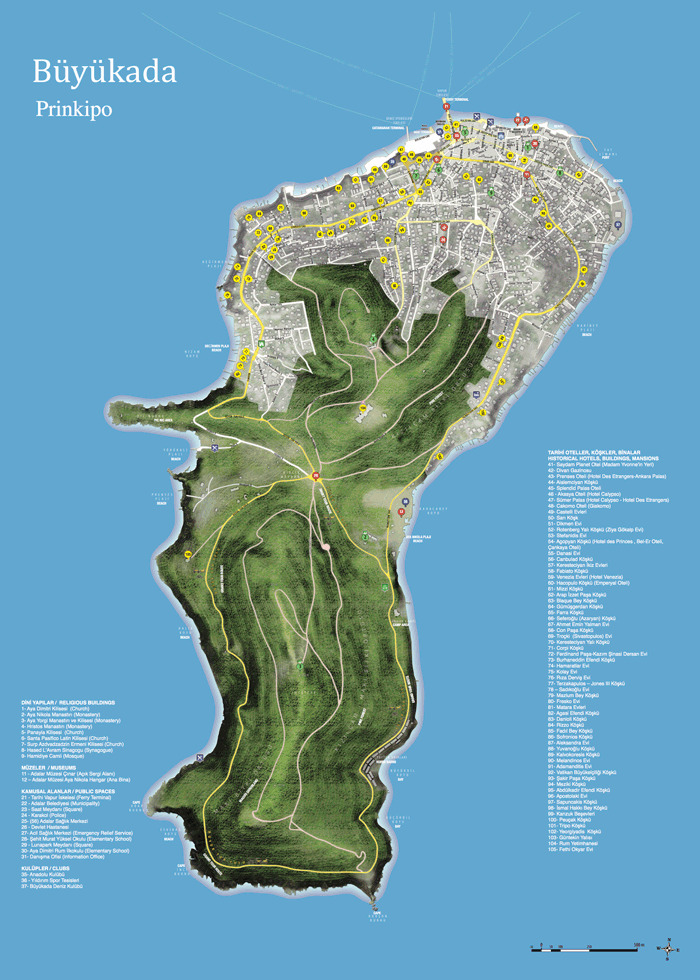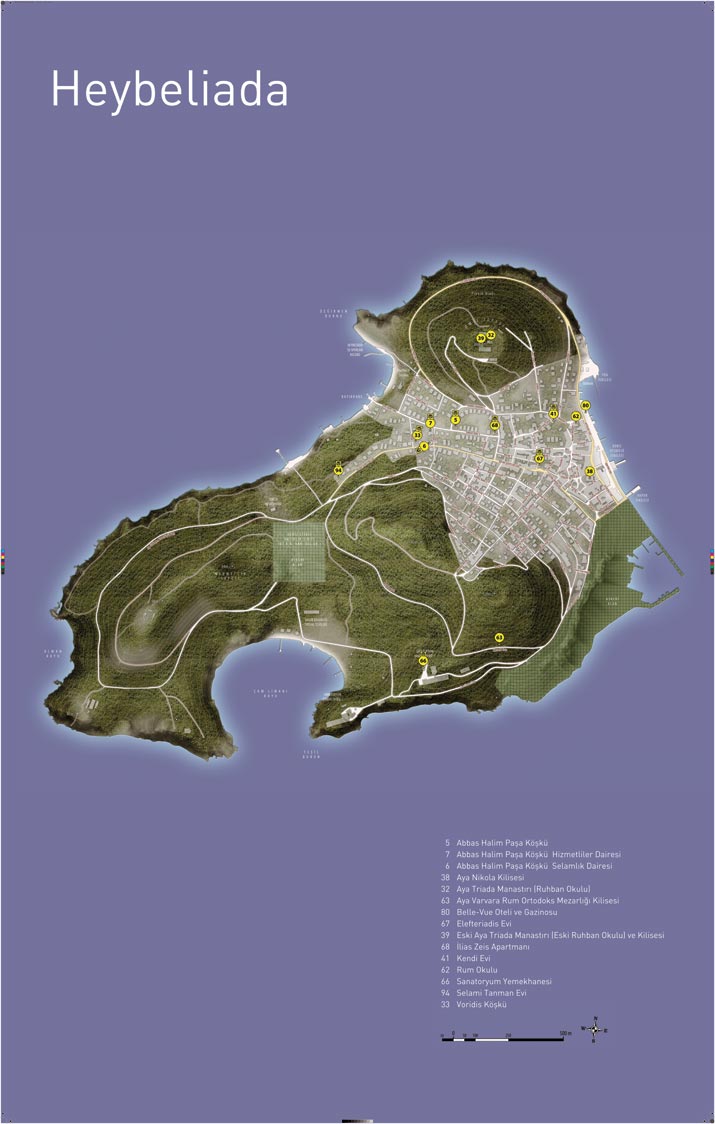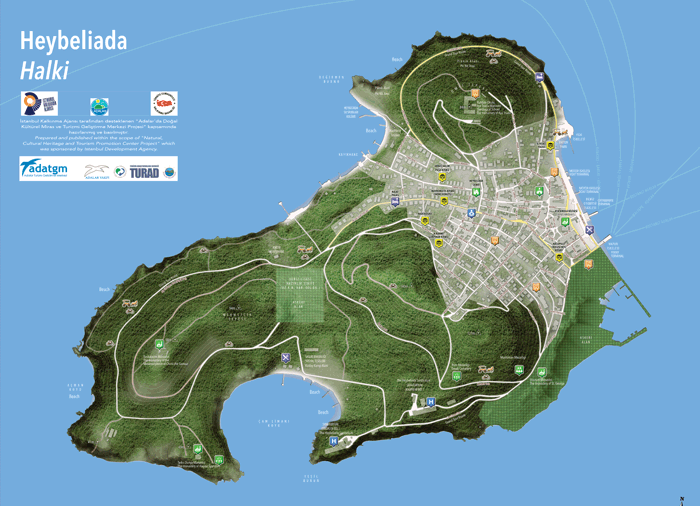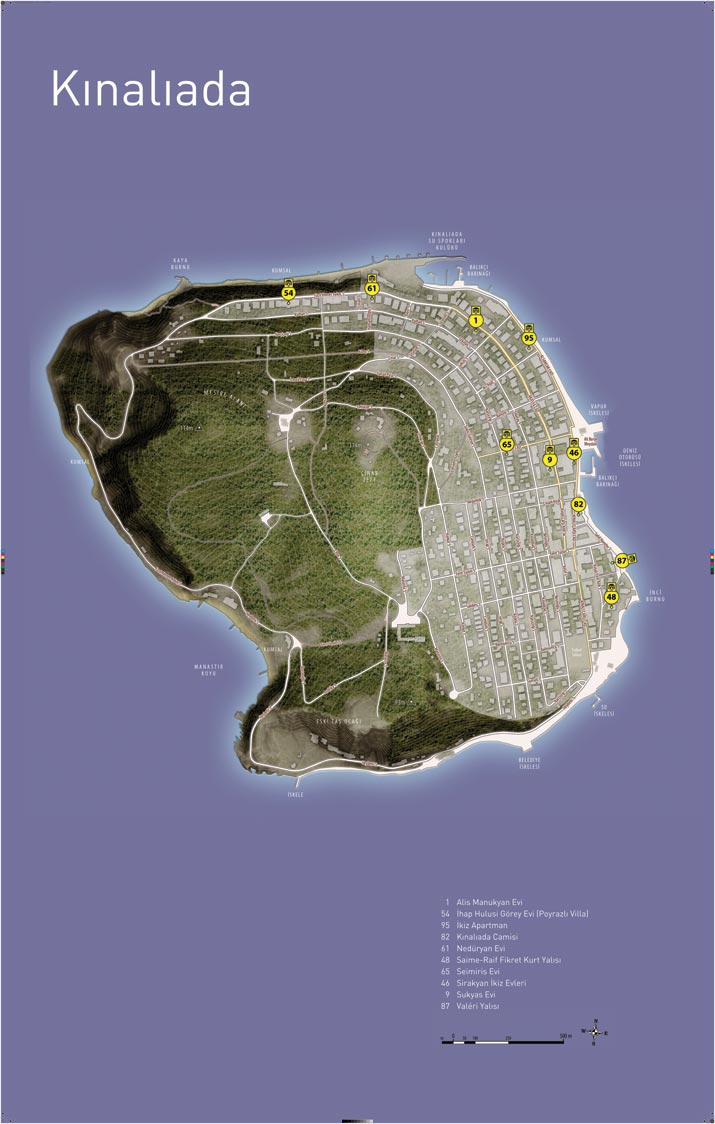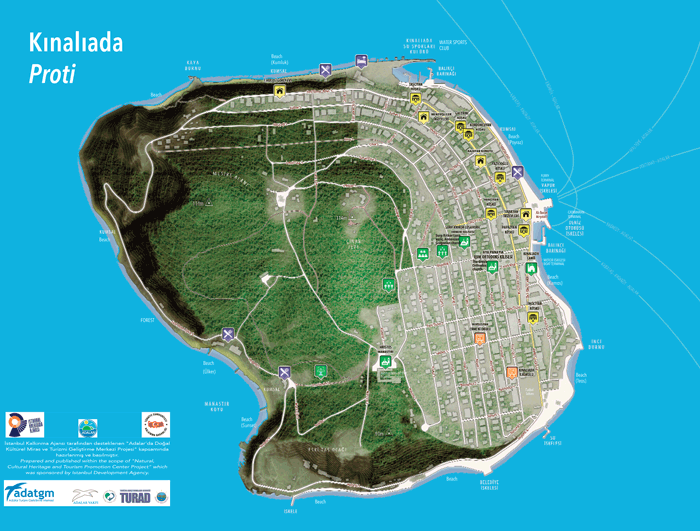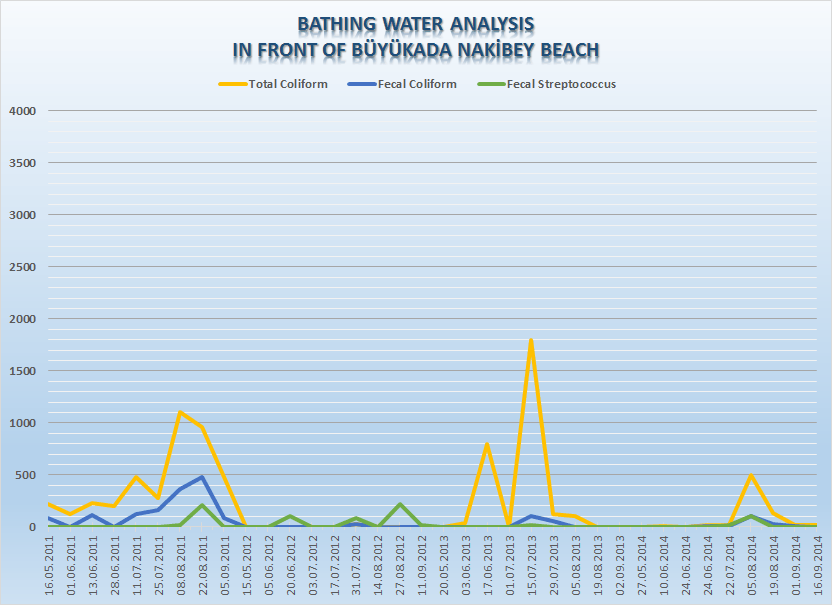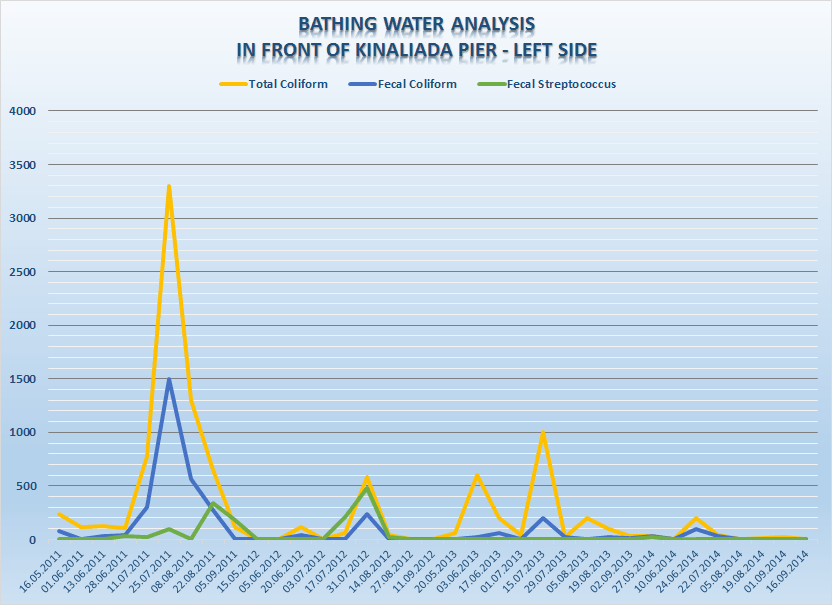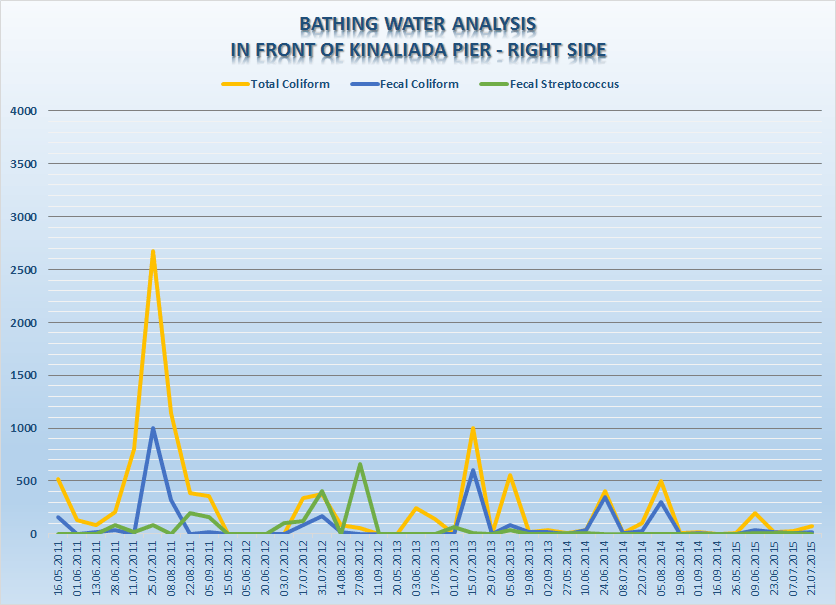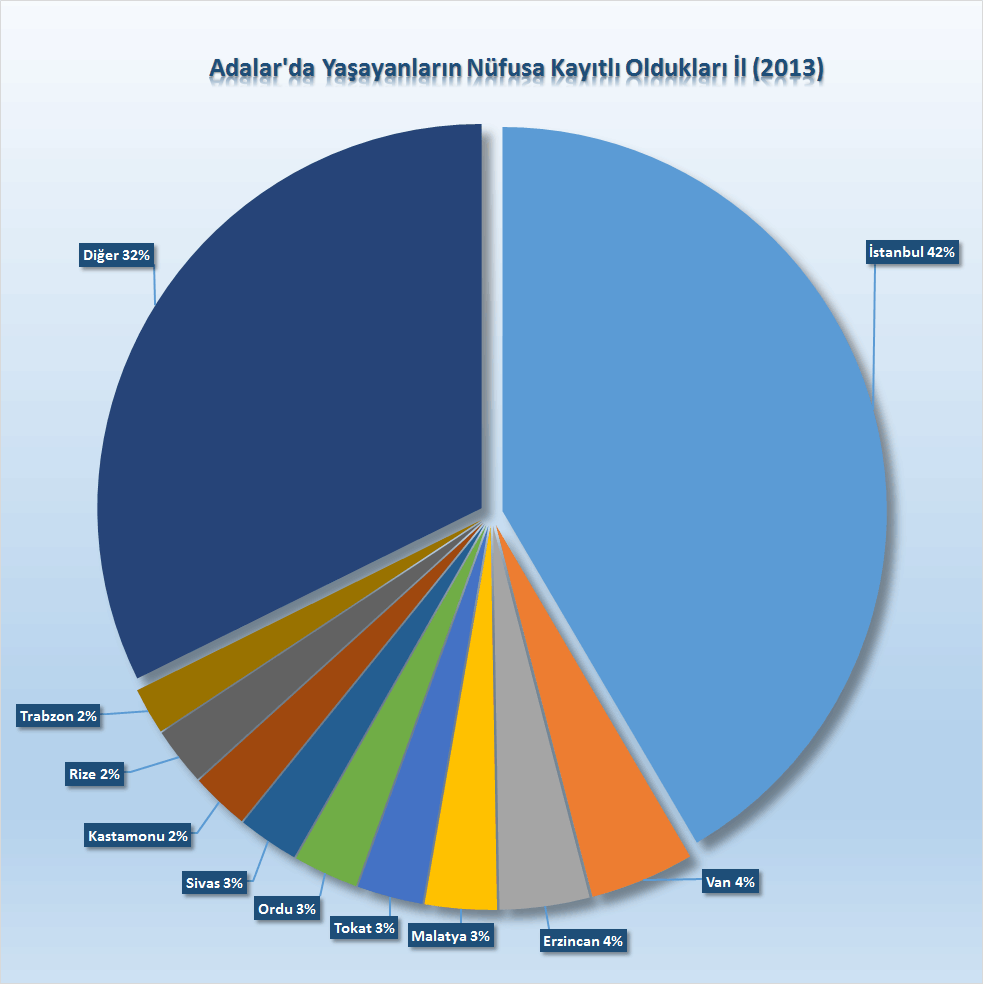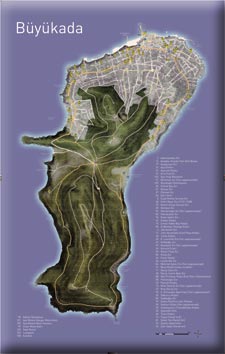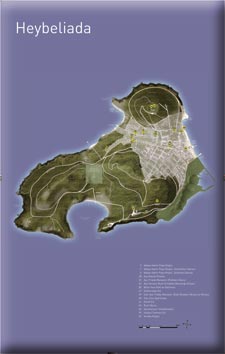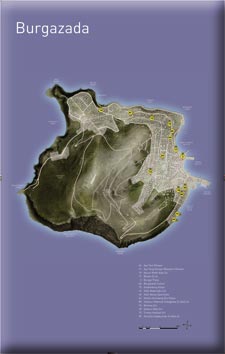English
Spring in the Islands
- Details
- Created on 01 May 2015
- Last Updated on 04 May 2015
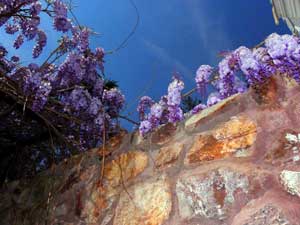 After a cold and long winter, in May, spring is finally here in Istanbul. Now, it is the right time for Adalar.
After a cold and long winter, in May, spring is finally here in Istanbul. Now, it is the right time for Adalar.
Gardens and small streets are colored with wistarias, judas trees, lilacs and various flowery plants.
Temperature is ideal for hiking, cycling or making phaeton tours.
Number of boat services that were reduced in winter are increased now. It is easier now to reach Islands from Kabataş, Bostancı or Kartal. (Summer Schedules of Seabus and City Line ferries will start after beginning of school vacation).
Please see Mavi Marmara and Prens Tour websites for motorboat schedules. You can also find the schedules all together in our website.
Photo: Turgut Kuli
June on the Islands
- Details
- Created on 01 June 2015
- Last Updated on 27 August 2015
 Elections, schools, exams and everything is over. Now, it is vacation time. Hooray!
Elections, schools, exams and everything is over. Now, it is vacation time. Hooray!
Weather is still cool. Don’t say, ‘where is summer?’ Don’t be pessimistic. Cool weather and rain will go away soon. Swimming time is starting in Adalar.
On some days in April and May, Marmara was covered with brown foam. We witnessed the white foam before. Unfortunately, this problem, defined as algae burst by scientists, repeats more frequently. People living around Marmara and especially local managements bear big responsibility for this. Seawater around Adalar has still the cleanest in Marmara. You can find pollution measurements on our site. You can see the most recent measurements of the beaches and decide accordingly.
Almost all sea vehicles switched to summer timetables. You can look at timetables of IDO, City Lines, Mavi Marmara and Prens Tour at their own web sites. You can also find the schedules all together in our website.
Summer 2015 on the Islands
- Details
- Created on 13 July 2015
- Last Updated on 13 July 2015

Schools, exams, rain and Ramadan, now, finally it is mid-summer. Exciting days have come after relatively calm days. We want to concentrate on another side of the activities. Culture and art activities.
While activities in the city consist of open air concerts only, activities on the Islands increase in every aspect.
Restaurants, beaches, water sport clubs, Anadolu Club of Büyükada are becoming addresses of entertainment, concerts, races and exhibitions from time to time.
Summer programs of Çelik Gülersoy Culture and Art Center (old Adaevi), Saklı Bahçe, Büyükada Library, Adalar Kültür Derneği Club House have been already announced.
A new one, Dutlu Bahçe at Heybeliada is added to the above centers.
Some important cultural activities in this summer are as follows;
Austria Days in the Islands will be held between 21-25 July. There will be 4 concerts at cultural activity areas of Büyükada and Heybeliada and one movie at Lale Theater, the only open air theater of Büyükada and all Islands. Details can be found below.
This year, Islands are also included as one of the activity areas of 14th İstanbul Biennial, from 5th of September to 1st of November. 5 areas of Büyükada will be used for the Biennial.
It was our dream to see the Islands as an important culture and art center. Now it is being realized by civil initiative. This dream is developing step by step not like the festivals made by municipalities of seaside towns, which were bursting like bubbles. Now our target is to increase cultural activities on the islands covering whole year instead of summer months only.
This article is prepared for those asking what they can find if they go to Islands in the summer months.
February and March on the Islands
- Details
- Created on 01 November 2014
- Last Updated on 02 February 2015

Now it is Mimosa time.
As we mentioned before, every season is beautiful on the islands. Islands are getting ready to be colored yellow while everywhere else colors of nature are fading due to dark winter days. With mimosas, the Islands are greeting the awakening of nature earlier than everwhere else.
Mimosas in the gardens and the hills of the Islands are going to show themselves by blooming yellow flowers starting mid February. This festivity will continue up to the end of April, depending on the weather conditions. Mimosa is one of the plants of this region, it is a kind of acacia. There are two mimosa species in Turkey. One is İzmir Mimosa that has no scent and the other is the Island Mimosa that has a beautiful fragrance. People are very much interested in mimosas because of their beauty and pleasant scent. They are sold on the Islands and in the city. But they are more beautiful on their branches. Come to the Islands to see them in their own environment. Walk around deserted roads and streets. Take pictures of yellow Mimosa trees and branches. Do not forget to bring food for cats and dogs that are waiting for you. You will feel wonderful there.
November on the Islands
- Details
- Created on 01 November 2014
- Last Updated on 02 February 2015
 Autumn is coming to an end. Winter is very close. But in İstanbul, winter does not come before January. Rarely, snow cold shows itself in November or December but does not last long. It keeps its momentum until January and February.
Autumn is coming to an end. Winter is very close. But in İstanbul, winter does not come before January. Rarely, snow cold shows itself in November or December but does not last long. It keeps its momentum until January and February.
When you are bored of crowd, traffic and noise, think about Islands. If you are coming from outside of İstanbul, do not return without visiting Islands.
Reaching there, is not as difficult as in the past. Frequent trips from Bostancı, Kartal and Kabataş in spring, autumn and winter are now available.There are trips at every 45 minutes in average to Büyükada and Heybeliada.
But Kınalı and Burgaz are not as lucky as them. It is better if you look at timetables before coming, you do not need to look at each timetable at City Line Ferry, Mavi Marmara or Prens Tour websites. You can easily see all available trips by just clicking ‘when can I go’ link in transportation section of our website. Please note following link for shortcut:
http://www.adalarturizm.org/cms/en/transportation/when-can-i-go
October on the Islands
- Details
- Created on 01 October 2014
- Last Updated on 05 October 2014

Last days of September in İstanbul were cool and windy but after these three days of extraordinary weather, beautiful autumn days are back.
Swimming season on the Islands still continues. Water temperature is not below 23-24 degrees. Excluding mornings and evenings, weather and sea water temperatures are nearly equal. Most of the beaches on the Islands will be open until the end of Sacrifice Feast, mid October. Islands are not only beaches and the sea. As we mentioned in September article, the most beautiful days of Islands, magnificent autumn, continue till December.
Despite raining and cool winds from time to time, sunshine is always there.
It is the time for biking, trekking, photographing the colors which cannot be found in cities any more, sitting at cafes, restaurants on the seaside, watching amazing scenery of Marmara sea and Islands from Aya Yorgi or Kalpazankaya.
We also would like to remind you, Heybeliada (Halki) Seminary is now open everyday, as you know it could be visited only with special permission in the past.
September on the Islands
- Details
- Created on 01 September 2014
- Last Updated on 01 September 2014
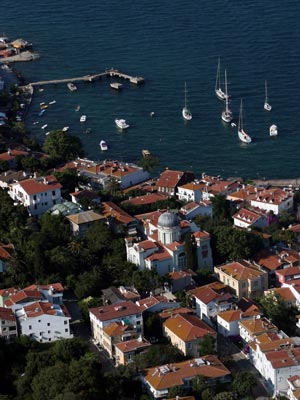
It is often said "September is the best month for visiting Istanbul and the Islands". Weather is around 20 °C. There may be days as warm as summer. Seawater temperature is not less than 25 °C.
After schools are opened, summer vacationists turn back to city. Intensity of crowds decreases.
But this is true only for mornings and evenings. During the day, especially Büyükada continues to attract thousands of daily visitors. September and October are the best months for taking photographs. Sunshine softens, nature changes its color from green to yellow, red and many other colors.
Fish mongers and fish restaurants of the Islands liven up after opening of fishing season on September 1st.
For the last two years, fishing with drag net at surroundings of the Islands were forbidden for the whole year. Thanks to this precaution, fish populations around the Islands have increased considerably compared to previous years. Local fishermen of Islands carry more fish to the market. You can find various very fresh fishes such as bluefish, bonito, horse mackerel, red gurnard at fishermen’s tables on the streets.
Sedef, the quietest of islands that are inhabited, is followed by Burgaz, Heybeli, Kınalı and Büyükada with respect to quietness.
As Büyükada attracts daily visitors the most, it seems that it will also be the liveliest in September. But every island has places that are out of sight and away from crowds. We suggest that you should first decide how you would like to spend your day, then make your choice.
But, the best choice is to stay for nights on few islands during week or weekends. Although transportation is quite frequent now, do not forget that the best time on the Islands is either morning or evening hours. Enjoy beauties without having the stress of going back to the city. How about finding a hotel to stay? There are many alternatives. You can reach them from hotels page of our web site.
August on the Islands
- Details
- Created on 01 August 2014
- Last Updated on 01 September 2014
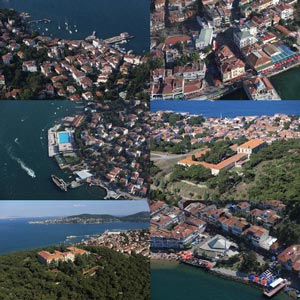
Ramadan Feast crowd has disappeared. Typical pace of summer months is back on the Islands. Number of visitors on Islands is changing from one island to another.
Sedef, the quietest of islands that are inhabited, is followed by Burgaz, Heybeli, Kınalı and Büyükada with respect to quietness.
As Büyükada attracts daily visitors the most, it seems that it will also be the liveliest in August. But every island has places that are out of sight and away from crowds. We suggest that you should first decide how you would like to spend your day, then make your choice.
But, the best choice is to stay for nights on few islands during week or weekends. Although transportation is quite frequent now, do not forget that the best time on the Islands is either morning or evening hours. Enjoy beauties without having the stress of going back to the city. How about finding a hotel to stay? There are many alternatives. You can reach them from hotels page of our web site.
Büyükada Map – Guide
- Details
- Created on 24 July 2014
- Last Updated on 31 July 2014
Guide with map for Büyükada. Places to visit. Sightseeing. Tips for daily trips., Turkish- English. 70x100 cm, coated paper.
Our Islands DVD and CD
- Details
- Created on 24 July 2014
- Last Updated on 02 August 2014
OUR ISLANDS
Through the Eyes of a Musician
“Our Islands: Through the Eyes of a Musician” is a documentary that looks at the individual lives and stories of a culturally diverse group people living on Princes’ Islands in Istanbul. It presents dramatic episodes of life on the islands and showcases a rich musical heritage. These islanders make up a unique microcosm of people – artists, fisherman, philosophers, phaeton drivers and housewives – all with unique stories; they have deep bonds with the past and strong ideas about the present and the future.
The documentary also follows the journey of Eren Balkan (a trained actress) who has come to the island for her Masters in architecture. In her search for key architectural sites on the islands, she interacts with the islanders. Director, Nedim Hazar, a resident islander and musician, narrates her journey.
Music Coordinator, Geo Schaller, and musicians Vassiliki Papageorgiou and Taner Öngür weave an enchanting musical thread throughout the documentary, a paean to their beloved Princes’ Islands, that culminates in the closing song: “My heart is for only for you and the islands/There is no one else.” The words are sung with a hint of sadness as we are reminded of Istanbul’s fading cultural heritage in the face of relentless growth and modernization.

Our Islands DVD and CD are sold separately. Each of them is 20 TL. DVD and CD can be bought at the bookstore on the entrance of historical boat pier, at newsstand next to pier at Büyükada, at Information booth nearby Kartal Boat Pier, at Heybeliada and at newsstands at Burgazada and Kınalıada. DVD and CD’s are also sold at large bookstores in İstanbul.
Guide Books, Albums, Documentaries for Islands
- Details
- Created on 24 July 2014
- Last Updated on 01 August 2014
You can buy Guide Books, Albums and Documentaries for Islands at the bookstore at the entrance of historical boat pier and at newsstand next to pier at Büyükada, at Information booth nearby Kartal Boat Pier, at Heybeliada and at newsstands at Burgazada and Kınalıada. Books and guides are also sold at large bookstores in İstanbul.
Please visit İdefix in order to buy Guide and books via internet.
Special Islands Gifts
- Details
- Created on 24 July 2014
- Last Updated on 31 July 2014
You can buy special islands gifts from Islands Museum Reception at Büyükada and from Information booth nearby Kartal Boat Pier and at Heybeliada. It is also possible to buy special islands gifts from gift stands at Büyükada and other Islands.
Symposium
- Details
- Created on 28 September 2013
- Last Updated on 30 July 2014
SEMPOZYUM
Kültürel etkinlikleri, turizm ürünü olarak değerlendirmek
Cultural events as tourism products of the cities
11 Ekim 2013 Cuma, Büyükada Splendid Palas Oteli
Friday 11 October 2013, Büyükada Splendid Palace Hotel
Program / Programme
09.00 – Kayıt / Registration
9.30-10.00 Açılış konuşmaları / Opening Speeches
Teoman Göral
TransTeo Turizm YK Başkanı, Adalar Turizm Geliştirme Merkezi Koordinatorü
Chairman of Trans Teo Tourism, Coordinator of Tourism Promotion Center of Princes’ Islands
Nesrin Bedeloğlu
İSTKA (İstanbul Kalkınma Ajansı) Değerlendirme Uzmanı
Istanbul Development Agency (ISTKA) Assessment Expert
Bahattin Yücel
Turizm Araştırmaları Derneği (TURAD) Başkanı, Turizm Eski Bakanı
President of Tourism Researches Association, Former Minister of Tourism
Dr. Mustafa Farsakoğlu
Adalar Belediye Başkanı / Mayor of Princes’ Islands
Prof. Dr. Ahmet Emre Bilgili
İstanbul Kültür ve Turizm İl Müdürü / Director of Culture and Tourism of Istanbul
10.00 - 11.15 : 1. Oturum / 1st Session
Dünyada iyi örnekler / Stories of best practice in the world
Moderatör: Suay Aksoy
Uluslararası Müzeler Konseyi (ICOM) Danışma Kurulu Başkanı ve İK üyesi
ICOM (International Counsel of Museums, Chairperson of the Advisory Committee and Member of Executive Council
Konuşmacılar / Speakers:
Björn Stenvers
Amsterdam Müzesi / Amsterdam Museum
(Amsterdam örneği / The Amsterdam case)
Ertan Sakallı
Rewe-Der Tour Tur Ürün ve Kontrat Müdürü / Director of Products and Contracts, Rewe- Der Tour
(Tur Operatörlerinin gözünden Avrupa şehirleri ve İstanbul / European Cities and Istanbul through the Eyes of Tour Operators)
Dr. Stella Kladou
Istanbul Bilgi University, Hellenic Open University, University of Rome "La Sapienza" TUBITAK fellow
(Roma-Atina-İstanbul’un turistler gözüyle kültürel marka değerleri / Brand Values of Rome-Athens-Istanbul through the Eyes of Tourists)
11.15-11.30: Kahve Arası / Coffee Break
11.30 - 13.00: 2. Oturum / 2nd Session
İstanbul, kültürel etkinliklere yerli-yabancı ziyaretçilerini çekebiliyor mu? İyi örnekler, sorunlar...
Is Istanbul able to attract visitors to cultural events? Stories of best practice, problems…
Moderatör: Bahattin Yücel
Turizm Araştırmaları Derneği (TURAD) Başkanı, Turizm Eski Bakanı
President of Tourism Researches Association, Former Minister of Tourism
Konuşmacılar / Speakers:
Görgün Taner
İKSV Genel Müdürü / General Director of IKSV
Cem Yegül
Pozitif Grup Y. K. Başkanı / Chairman of Pozitif Group
Ali Güreli
Contemporary İstanbul YK Başkanı / Chairman of Contemporary Istanbul
Süha Uyar
Plan Tur Genel Koordinatörü / General Coordinator of Plan Tour
13.00 - 14.30 - Yemek arası / Lunch Break
14.30 - 16.00: 3. Oturum / 3rd Session
İstanbul'da kurumsal çalışmalar, projeler üzerinden modeller ve deneyimler
Corporate undertakings, models developed through projects and experiences in Istanbul
Moderatör: Halim Bulutoğlu
Konuşmacılar / Speakers:
Çiler Yıldız
İstanbul Modern Sanat Müzesi Genel Müdürü / Managing Director of Istanbul Museum of Modern Art
İstanbul Turizmi'nin yeni çekim alanı, Çağdaş Sanat Projeleri üzerine / The new attraction area of Istanbul Tourism about contemporary art projects
Bilgesu Güneş Yerli
İRO İstanbul’da Alternatif Tur Yolları Proje Yöneticisi
Manager of IRO Project “Alternative Tour Routes in Istanbul”
Cihan Yigin
Adalar’da Kültürel, Tarihi Miras ve Turizm Geliştirme Merkezi Proje Yöneticisi
Project Manager at the Center for Cultural and Historical Heritage and Tourism Promotion on Princes Islands
16:00 - 16.15 Kahve Arası / Coffee Break
16.15-17.30 Soru ve Yanıtlar / Questions and Answers
İLETİŞİM, MEKAN, KONUM VE DİĞER BİLGİLER
İletişim:
Sempozyumla ilgili her türlü bilgi, soru için: This email address is being protected from spambots. You need JavaScript enabled to view it.
Kayıt:
Sempozyumu izleyecek katılımcılar için kayıt zorunlu değildir, ama sempozyum mekanı sınırlı kapasitede olduğu ve daha önemlisi Kabataş’tan gelecekler için Deniz Taksi kaldırılacağı için özellikle Kabataş hattını kullanacak katılımcıların kayıt yaptırması istenmektedir. Lütfen katılım bilginizi This email address is being protected from spambots. You need JavaScript enabled to view it. adresine bildiriniz. Kabataş’tan gelecekler özellikle bildirimde bulunmalıdır. Büyükada’dan dönüş için deniz taksi opsiyonu yoktur.
Sempozyum mekanının konumu:
Sempozyum Büyükada’nın tarihi oteli Splendid Palas’da yapılacaktır. Otel, iskelelere 5 dakika yürüme mesafesindedir.
Simultane tercüme:
İngilizce ve Türkçe simültane tercüme yapılacaktır.
Çay-Kahve ikramı:
Toplantı aralarında çay-kahve ve atıştırmalık ikramı vardır.
Yemek:
Büyükada merkezdeki café ve lokantalar kısa yürüme mesafesindedir.
Ulaşım
Büyükada’ya gidiş:
Bostancı’dan 08.45’de Mavi Marmara iskelesinden motor seferi vardır. 09.15’de Büyükada’ya ulaşılmaktadır.
Kabataş’tan Bostancı’ya 08.30’da Deniz Otobüsü seferi vardır. Deniz Otobüsü ile Bostancı’ya geleceklerin Büyükada’ya transferi Bostancı iskelesinden Deniz Taksi ile yapılacaktır.
Dönüş:
Büyükada’dan Kabataş, Kartal ve Bostancı’ya vapur ve motorlarla dönülmektedir.
Büyükada'dan Kabataş'a
| Saat / Time | Taşıt / Transport |
Firma / Company |
Süre / Duration |
| 14:30 | Motor/Motorboat | Dentur-Mavi Marmara | 01:15 |
| 15:00 | Vapur/Ship | Şehir Hatları/City Lines | 01:40 |
| 16:00 | Motor/Motorboat | Dentur-Mavi Marmara | 01:15 |
| 17:00 | Motor/Motorboat | Dentur-Mavi Marmara | 01:15 |
| 17:20 | Vapur/Ship | Şehir Hatları/City Lines | 01:40 |
| 17:30 | Motor/Motorboat | Dentur-Mavi Marmara | 01:15 |
| 18:00 | Motor/Motorboat | Dentur-Mavi Marmara | 01:15 |
| 18:15 | Vapur/Ship | Şehir Hatları/City Lines | 01:40 |
| 18:30 | Motor/Motorboat | Dentur-Mavi Marmara | 01:15 |
| 19:30 | Motor/Motorboat | Dentur-Mavi Marmara | 01:15 |
Büyükada'dan Bostancı'ya
| Saat / Time | Taşıt / Transport |
Firma / Company |
Süre / Duration |
| 14:35 | Motor/Motorboat | Mavi Marmara | 00:45 |
| 15:50 | Motor/Motorboat | Mavi Marmara | 00:30 |
| 16:40 | Motor/Motorboat | Mavi Marmara | 00:30 |
| 17:20 | Motor/Motorboat | Mavi Marmara | 00:30 |
| 17:35 | Motor/Motorboat | Mavi Marmara | 00:45 |
| 18:05 | Vapur/Ship | Şehir Hatları/City Lines | 00:45 |
| 18:35 | Motor/Motorboat | Mavi Marmara | 00:30 |
| 19:05 | Motor/Motorboat | Mavi Marmara | 00:45 |
| 19:10 | Deniz Otobüsü/Seabus | İDO | 00:20 |
| 19:50 | Motor/Motorboat | Mavi Marmara | 00:45 |
This Month on the Islands
- Details
- Created on 01 July 2014
- Last Updated on 01 August 2014

After heavy traffic of daily visitors in spring days, Islands reached calm days in Ramadan.
It is the right time for those who say that it is not possible going to Islands in summer time.
Normally, roads which are very difficult to move due to Phaeton, bike and pedestrian traffic are at April calmness. Beaches, generally difficult to find chaise lounge or parasols at them, now are in best condition.
Sea is in better condition after falling of mosses in may and june. Keep in mind that you can not find this sea water in Aegean or Mediterranean Region.
Brief Info On The Islands
- Details
- Created on 16 February 2013
- Last Updated on 01 April 2013
Islander
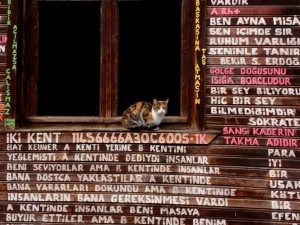 GONZALO: Had I plantation of this isle, my lord,
GONZALO: Had I plantation of this isle, my lord,
ANTONIO:He’ld sow’t with nettle-seed.
SEBASTIAN: Or docks, or mallows.
GONZALO: And were the king on’t, what would I do?
SEBASTIAN: Scape being drunk for want of wine
GONZALO: I’ the commonwealth I would by contraries Execute all things; for no?kind of traffic Would I admit; no name of magistrate; Letters should not be known; riches, poverty, And use of service, none; contract, succession, Bourn, bound of land, tilth, vineyard, none; No use of metal, corn, or wine, or oil; No occupation; all men idle, all; And women too, but innocent and pure; No sovereignty.
Shakespeare,
The Tempest
Serenity
Automotive transport is banned at the Islands, except for a few municipal vehicles. Otherwise the only means of transport on Burgazada, Heybeliada and Büyükada is by fayton, or horse-drawn carriage, while on Kınalıada one must either walk or ride a bicycle.
Nature
"Nature, insatiable in giving, has diversified the capital not only with the Bosphorus and the Golden Horn, but with the tiny archipelago of the Princes’ Isles. More than Ischia and Capri are to Naples, are Khalki, Prinkipo and their sister islands to Constantinople.
Nothing more ideal can be pictured than the loveliness of these islands in May and June. The hills are covered with pine forests, and the meandering shores are indented with shaded and sequestered bays.
Edwin Grosvenor -1895
 ““The sea, at a far away shore was set ablaze like a crimson bouquet. I have carved all the details in my mind with a strange intuition. A cutter with pale yellow sails adorned this view for an instance. Then that cruiser sailed out of the sea burning up in flames, and disappeared into the blue.
““The sea, at a far away shore was set ablaze like a crimson bouquet. I have carved all the details in my mind with a strange intuition. A cutter with pale yellow sails adorned this view for an instance. Then that cruiser sailed out of the sea burning up in flames, and disappeared into the blue.
The colors blazed for the last time, and the sun charred for the last time. The mansions midst of their gardens glowed with the last rays, looking more like fake showpiece cakes on pastry shop windows. The walls of the gardens were low and painted in whitewash.”
The mimosa, silk trees, exuberant hibiscuses on the ramps of the Island hills created an extraordinary shower of reverie. And all surrendered their yellow, pale pink, white and purple flowers to the light breeze.”
Selim İleri,
Fantasy and Pain
Secluded Life, Inaccessibility
“Because I live a total secluded life on top of a mountain, visiting my house cannot be compared to visits in the city. Therefore I see it necessary to make some explanation: Th real door of the residence is on the west side; but it is kept locked with chains because it is located at a spot where even goats would have trouble climbing. We opened a henhouse door on the east side, so we enter and exit from there. However there is neither a door bell nor a knocker... Neither a bell nor a rattle... One must pick up a large rock and start hitting as hard as possible until the door wears down with the thought that it has a penance to pay. Because there isn’t a person inside that can hear the first knocks. Some visitors head back without being able to make themselves heard; I have benefited from this primitive deaf door considering my asocial life.”
From the letter of Hüseyin Rahmi sent to Refik Ahmet Sevengil
Sightseeing
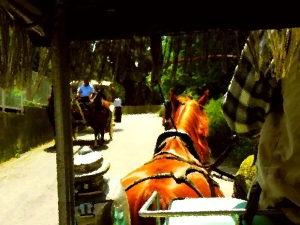 One day the weather was really hot, we were staying on the island with my five year old daughter Rüya and we decided?to go sightseeing on a horse drawn buggy.?I sat backwards in the carriage and my daughter right in front of me. She would be facing the direction we were heading. We passed through gardens with flowers, low walls, wooden houses and vegetable gardens. I was looking at the facial expressions of my daughter as the carriage pattered on, wondering what she saw in the world...
One day the weather was really hot, we were staying on the island with my five year old daughter Rüya and we decided?to go sightseeing on a horse drawn buggy.?I sat backwards in the carriage and my daughter right in front of me. She would be facing the direction we were heading. We passed through gardens with flowers, low walls, wooden houses and vegetable gardens. I was looking at the facial expressions of my daughter as the carriage pattered on, wondering what she saw in the world...
Things, objects, trees, walls, posters, writings, streets, cats. Asphalt. Hot. As hot as it can be...
We went through the forest but the forest wasn’t cool either. It was like as if heat was coming out of it. The horses really slowed down as the hill began to become steeper.
We could hear the crickets. The carriage was going really slow and the path became very narrow by the pines, then suddenly we saw a view.”
The driver said ‘Brrrs’ and the horses stopped. He said ‘Let them rest’.
We stopped and enjoyed the scenery... There was a cliff at our side. And below were rocks, the sea, and the other islands buried inside a mist.”
Orhan Pamuk,
Other Colours
A Day In The Island
“The sun had descended more now, and the seagulls are singing like crazy, cormorants are getting out of the water and flapping their wings like crazy to accelerate. The sea is still calm besides the waves hitting the shores of Sivriada just ahead.
We row towards Sivri and land the boat on the shore with peeblestone (...) A single small purple light is ecstatically dancing on the bay. And then it gets dark. The lighthouse of Yassıada starts to operate and sparkles?once in every two minutes. A sail has set sail, coming from a distance.
First of all we slurp the sea urchins. Karayan puts a can on top of the rocks surrounding the fire, scrubs the fish with oil and garlic, stuffs the fresh fennel in their stomachs and lies them down on the heated can. A strong sizzle is heard.”
Exile
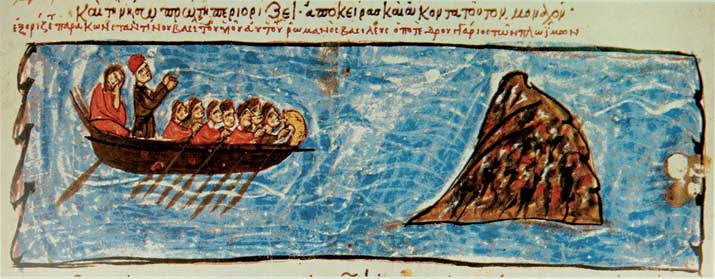
Romanus IV Diogenes (r. 1067-71) was deposed in 1071 after his catastrophic defeat by the Seljuk Turks at the battle of Manzikert. His successor, Michael VII Doucas (r. 1071-8), blinded Romanus and exiled him to the monastery of the Transfiguration on Proti, where he died on 4 August 1072.
Life
August 11th 2005, Thursday, 06.35
İstanbul from a thin, long and wooden balcony.
June 25th, around 07.00
I could not tell if it was the sunlight that woke me up this morning, or the crazy chorus practice of seagulls.
July 19th, 07.30
A walk in the afternoon and one at?night is both unusual and natural, and this enabled us to load the two islands, and the inner impressions generated from the two islands on to our scales.
September 3rd, 07.00
In the end we stayed, delaying the?return to this evening – it is good that we did so: putting aside the rheumatism pains that are driving me crazy; we spent another wonderful day on the island. October
October 14th, 07.50
Island = Isola. At last, the island is left to the islanders.
Enis Batur,
The Island Notebooks
Music
When Ahmet Rasim’s wife was seeing him off on the morning following a night of turning up late, she asked him not to be late saying, “Mind you don’t be late, I can’t take it anymore, be here before the night falls”. On the island ferry Rasim wrote lyrics for his wife’s complaint and his friend Tatyos Efendi composed this unforgettable song:
“Come before nightfall?Be early, don’t be late?I cannot stand it anymore Be early, don’t be late”
Poem
If you were to pass by the shore of Kumkapı
a) you would dream of having a delicious fish meal
b) you would want to walk on water to the Islands
c) you would think how fast life goes by
d) you would remember you owed Agop five lira
Zahrad
Sunset
 “From whom did the kid from Kars hear this song; from where, when did he learn it, I don’t know...
“From whom did the kid from Kars hear this song; from where, when did he learn it, I don’t know...
But even when half a century and another ten years has passed, I still remember it like it was today, murmuring the song ‘I Am Waiting On The Shores of The Island’ in tears, sitting against the sunset on the wide, concrete old window of the Club Birlik, that’s still in its proper place today at the point where our house was where Halit Paşa Street and Atatürk Street intersects...
What was it in the song that affected me? Is it the tune that I still love today??Is it the touching lyrics??Is it the tremendous sunset that fades from red to pink?”
Ataol Behramoğlu,
My Princes’ Islands
Memoirs
“It was a very hot summer day, a terribly hot day; I could not manage to sleep at home. There were wooden benches in the garden, I quickly went to one of them. I realized that my father was lying down on one of them; it was obvious that he couldn’t sleep either. ‘Is that you, girl?’ he said, ‘Come and lie down.’ We watched the stars together, me on one bench and my father on the other. My father began to talk about the stars, he told me their Persian names, and explained endlessly their paths.”
From the memoirs of Ela Güntekin
Vicinity
“In my childhood, Nizam Street was considered to be one of the most elegant and European styled vicinity of Büyükada, and was also one of the relatively more liberated places in İstanbul. Lined up on this road,?in small and large gardens, were luxurious mansions belonging to wealthy families local and foreign, whom people always talked about and whose names turned up in the papers daily. Mansions, one more beautifully adorned and spectacular than the other... So much so that, as you walked pass by them the street seemed to allude to a more delicate and more nonchalant state at every step."
Abdülhak Şinasi Hisar,
Ali Nizami Bey’s Occidentalism and Sheikhdom
Pleasure
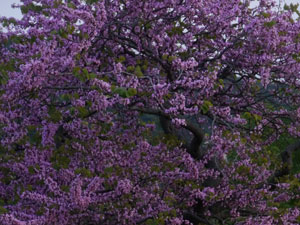 “We finally rented a house and went to Burgaz. The house had an old style and a wide sofa, wisteria and a garden covered with roses and honeysuckles. Life totally changed for me there. I felt as if I was living in the house in Beşiktaş. It was situated on top of?a steep slope. The facade of the house was covered in pines all the way to the sea, and sandy beach below. I used to gaze at the blue sea from its windows.
“We finally rented a house and went to Burgaz. The house had an old style and a wide sofa, wisteria and a garden covered with roses and honeysuckles. Life totally changed for me there. I felt as if I was living in the house in Beşiktaş. It was situated on top of?a steep slope. The facade of the house was covered in pines all the way to the sea, and sandy beach below. I used to gaze at the blue sea from its windows.
I went there sick, but found my spiritual balance as well as physical. I lived among?the beauty and daily pleasures given to man through nature. In the mornings, the kids with their nanny and I with the cook; we would climb up to the pine groove on top?of donkeys, and I used to eat, drink and virtually live there all day long.”
Halide Edip Adıvar,
The House With Purple Wisteria, (Memoirs of Halide Edip)
Climate
- Details
- Created on 16 February 2013
- Last Updated on 01 April 2013
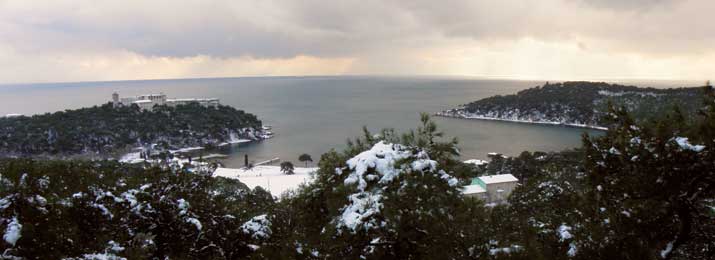
The Princes’ Islands generally enjoy milder weather than central Istanbul. In summer, island temperatures range from a daytime high of 28º Celsius to a nighttime low of 20° C. The summer sky is usually clear, though after August 15 there may be occasional rainfall. The water temperature of the Sea of Marmara averages 22° C during the summer.
September and October are the loveliest months on the islands. After the middle of September, the average temperature decreases to 25º C with some light rain. During the winter months (December through March), harsh northern winds may bring colder temperatures, but the sunny days are perfect for an enjoyable winter outing.
In April and May, the islands are a paradise of greenery with high temperatures between 18 and 22º C.

Nature of the Princes' Islands
- Details
- Created on 17 February 2013
- Last Updated on 01 April 2013
The Vegetations of Princes' Islands
Meditarrean and Black Sea climates’ characteristics and vegetation can be found together in Princes Islands. Besides the residential areas, the vegetation of the island today is pinus brutia (kızılçam) and maquis of the Mediterranean whereas exotic plants are dominating the residential ares and gardens.
Pinus Brutia
It’s a matter of discussion whether the Pinus Brutia is the natural vegetation of the Islands or not as the photos from the 19th century depict pinus brutia plantation in some parts of the island, while at the same time, some parts are treeless. Artemidorus, who lived in 1st and 2nd centuries B.C, talks about the Princes Island as Pityodes (Çamlık).
Maquis
Maquis are the characteristic plant association of the Mediterranean climate and they form a group under different names. For instance, while they can be named as tall maqui or short maqui, they can also be referred by its dominant type.
Exotic Plants
In all of the Islands, exotic (yabancıl) plants stand out around the residential areas, gardens, parks and roadsides. They capture quite a lot of attention by their intriguing kinds especially in the gardens of historical villas and mansions. Besides the plants representing the mystical nature of Anatolia and Far East, plants special to South America and Japan are also seen.
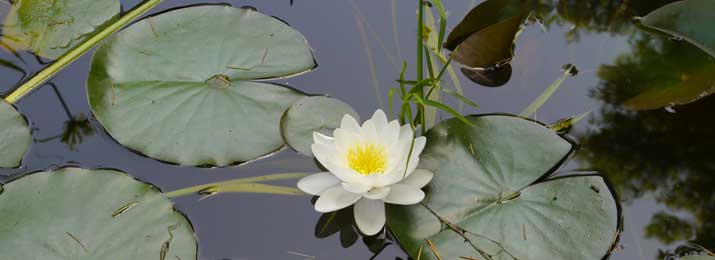
Princes' Islands
- Details
- Created on 17 February 2013
- Last Updated on 01 April 2013
Princes' Islands
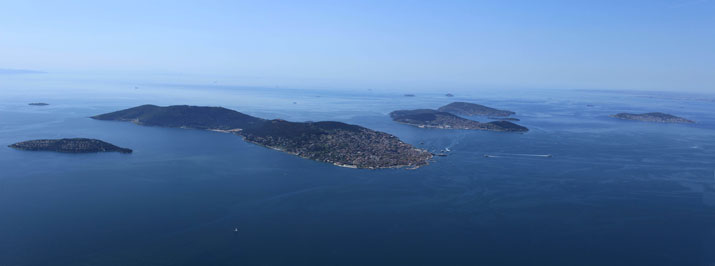
The Princes’ Isles, known in Turkish as Adalar, or the Islands, are a little archipelago off the Asian coast of the Sea of Marmara southeast of the southern end of the Bosphorus. The isles have always been a maritime suburb of Istanbul, the great metropolis on the Bosphorus, Greek Constantinople, ancient Byzantium. The group consists of nine islands, all but four of them tiny and sparsely inhabited. The nearest is some fifteen kilometers from the ferry terminal in Istanbul at the confluence of the Golden Horn and the Bosphorus, the farthest about twenty-six kilometers, though in spirit they seem at a far greater remove than that, since they are so different in appearance and atmosphere from the imperial city on their western horizon.
Nine İslands

Ferries stop in turn at the four principal isles, the closest of which is Kınalıada ( known to the Greeks as Proti), followed by Burgazada (Antigoni), Heybeliada (Halki), and finally Büyükada (Prinkipo), the largest and most populous of the isles. During the summer months ferries also stop at Sedefadası (Antirovithos). There are a few summer residents on Kaşıkadası (Pita), but Tavşanadası (Neandros), Yassıada (Plati) and Sivriada (Oxia) are uninhabited, except for a single hermit now living on the latter isle.
Büyükada (Prinkipo)
Büyükada, the Greek Prinkipo, is the largest and most beautiful of the Princes’ Isles. This is the only one of the islands that most people visit and it is the summer resort par excellence.
With an area of 5.4 square kilometers, Büyükada is larger than the other three major islands combined. It is also the most populous of the islands, with about 6,500 residents year-round and some 40,000 in the summer.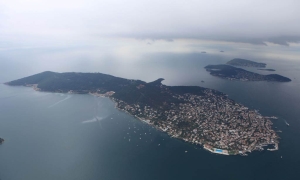
The island is about 4.3 kilometers long from north to south and averages about 1.3 kilometers in width from east to west. It has two lofty hills: Isa (Hristos or Christ) Tepesi, to the north, rising to a height of 164 meters, and to the south Yüce Tepe (Great Hill), known to the Greeks as Hagios Georgios (St. George), with an elevation of 202 meters, the highest peak in the Princes’ Isles. The two hills are separated in the middle of the island by a broad valley, known to the Greeks as Diaskelo. The northernmost part of the island is now completely built up, but farther south are lovely pine groves and other forests, wild cliffs plunging into the sea, and isolated sandy coves.
Heybeliada (Halki)
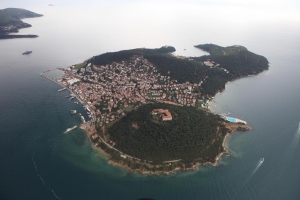 Heybeliada is the second largest of the islands, with an area of 2.35 square kilometers. It has a year-round population of about 5,500, which in summer increases to some 30,000. Halki, the Greek name of the island, which means "copper," comes from the copper mines that were worked here in antiquity, mentioned by Aristotle. The island took its Turkish name, Heybeli, from the word for saddlebag, heybe, which it is said to resemble because of the shape of its hills and their intervening valleys.
Heybeliada is the second largest of the islands, with an area of 2.35 square kilometers. It has a year-round population of about 5,500, which in summer increases to some 30,000. Halki, the Greek name of the island, which means "copper," comes from the copper mines that were worked here in antiquity, mentioned by Aristotle. The island took its Turkish name, Heybeli, from the word for saddlebag, heybe, which it is said to resemble because of the shape of its hills and their intervening valleys.
The hills are Ümit Tepesi, formerly known as Papaz Dağı (85 m.), in the north of the island, Değırmen Tepesi (136 m.) and Köy Tepesi (128 m.) in the center, and Baltacıoğlu Tepesi (98 m.) in the southwest. The core of the village is on the northeast shore, from where its houses spread in tiers along the slopes of Ümit Tepesi, Değirmen Tepesi, and Köy Tepesi and the valleys between them.
Burgazada (Antigoni)
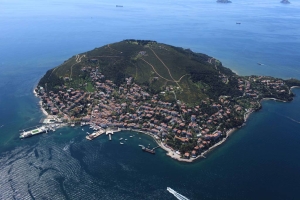 Burgazada is the third largest island in the archipelago, with an area of 1.5 square kilometers. It has a year-round population estimated at 1,500, which in summer increases to about 15,000.
Burgazada is the third largest island in the archipelago, with an area of 1.5 square kilometers. It has a year-round population estimated at 1,500, which in summer increases to about 15,000.
In antiquity the island was known as Panormos, but in Byzantine times it was called Antigoni, the name still used by the Greeks. The Turkish name of Burgaz is a corruption of the Greek pyrgos, or tower, from an ancient watchtower on its summit that is mentioned by Evliya Çelebi and other travelers up until the early nineteenth century. The watchtower can be seen on the summit of the island in an engraving done in 1794 by Cosimo Comidas. The engraving shows the island bare except for what appear to be an orchard and two or three cultivated patches on the side of the hill.
The single hill, Hristos Tepesi (Christ Hill), also known as Bayraktepe (Flag Hill), rises to a height of 170 meters in the middle of the island. The center of the village is on the northeast coast of the island, its houses stretching from there along the heights above the northern shore. The shore roads extend around all of the island except its inhospitable south coast, where precipitous cliffs hang over the sea.
Kınalıada (Proti)
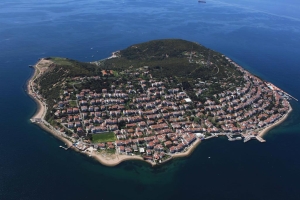 It is the smallest of the four major islands, with an area of 1.356 square kilometers. The island takes its Turkish name, which means "henna-red," from the color of the sandstone cliffs that plunge into the sea at its eastern end. The Greeks have always called the island Proti, or First, since it is the nearest of the islands to the city.
It is the smallest of the four major islands, with an area of 1.356 square kilometers. The island takes its Turkish name, which means "henna-red," from the color of the sandstone cliffs that plunge into the sea at its eastern end. The Greeks have always called the island Proti, or First, since it is the nearest of the islands to the city.
Kınalıada has three peaks, with Çınar Tepesi (Plane Tree Hill) rising in the northeast of the island to an elevation of 115 meters, Teşrifiye Tepesi (110 m.) in the center, and Manastır Tepesi (93 m.) in the south.
The island has a winter population of some 1,000, while in summer the number increases to about 15,000. The village spreads around the north and east sides of the island, sloping down in tiers along the slopes of the three hills. The focal point of the village, here as in the other three major isles, is the vapur iskelesi, or ferry landing, on the northeast shore. The new iskele for the sea bus is just beside the pier for the regular ferry on its south side.
Sedefadası (Antirovithos)
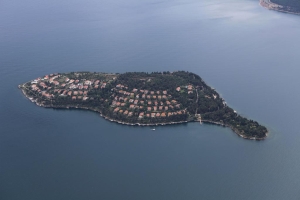 Sedefadası, the Greek Antirovithos, is about 1,200 meters east of the central part of Büyükada. Sedef is the fifth largest of the isles, measuring 680 by 250 meters, its highest point fifty-five meters above sea level. The name of the island is said to derive either from sedef (mother-of-pearl) or from sedefotu, the rue plant commonly found here.
Sedefadası, the Greek Antirovithos, is about 1,200 meters east of the central part of Büyükada. Sedef is the fifth largest of the isles, measuring 680 by 250 meters, its highest point fifty-five meters above sea level. The name of the island is said to derive either from sedef (mother-of-pearl) or from sedefotu, the rue plant commonly found here.
Sedefadası is served by ferry from mid-June to mid-September. Those who are not residents or their guests are not allowed to enter the gated community, but are restricted to a restaurant above the iskele and a pebble beach along the shore to the right of the landing stage. The most beautiful part of the island is its eastern shore, which is luxuriantly wooded with cypresses and umbrella pines as well as a rich variety of other trees.
Sivriada (Oxia) and Yassıada (Plati)
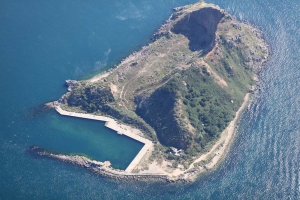 Sivriada and Yassıada are off to the west of the other islands of the archipelago, sixteen to seventeen kilometers south of the entrance to the Bosphorus and fifteen kilometers off the Asian coast. They can be reached by hiring a motor boat at any of the major islands.
Sivriada and Yassıada are off to the west of the other islands of the archipelago, sixteen to seventeen kilometers south of the entrance to the Bosphorus and fifteen kilometers off the Asian coast. They can be reached by hiring a motor boat at any of the major islands.
 The Greek name of Sivriada is Oxia and that of Yassıada is Plati. Sivriada, which is about two kilometers to the northwest of Yassıada, is somewhat the smaller of the two, but it is more noticable because its peak is more than twice as high as that of the other isle. The Turkish and Greek names are descriptive and mean the same thing in each case: Sivri-Oxia meaning "Pointed" and Yassı-Plati meaning "Flat." Yassiada was also known as Hayırsızada (Useless Island), a name still used by some local residents.
The Greek name of Sivriada is Oxia and that of Yassıada is Plati. Sivriada, which is about two kilometers to the northwest of Yassıada, is somewhat the smaller of the two, but it is more noticable because its peak is more than twice as high as that of the other isle. The Turkish and Greek names are descriptive and mean the same thing in each case: Sivri-Oxia meaning "Pointed" and Yassı-Plati meaning "Flat." Yassiada was also known as Hayırsızada (Useless Island), a name still used by some local residents.
Tavşanadası (Neandros)
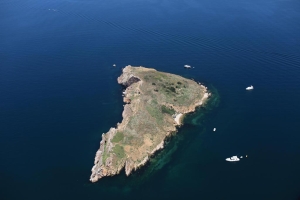 Tavşanadası, or Rabbit Island, known to the Greeks as Neandros, is some two kilometers off the southernmost point of Büyükada, from which it can be reached by hiring a motor boat at the iskele. It is the second smallest of the isles, after Kaşıkadası, with an area of 10,000 square meters, its highest point forty meters above sea level.
Tavşanadası, or Rabbit Island, known to the Greeks as Neandros, is some two kilometers off the southernmost point of Büyükada, from which it can be reached by hiring a motor boat at the iskele. It is the second smallest of the isles, after Kaşıkadası, with an area of 10,000 square meters, its highest point forty meters above sea level.
It is once known to both Turks and Greeks as Neandros, the most remote of the Princes’ Isles from Istanbul. The most beautiful part of the island is its southern shore, which is formed by a rock cliff that plunges sheer into the sea, with myriads of cormorants and seagulls perched like sentinels on its crags.
Vordonos Adası (Vordonosi)
About midway between Kınalıada and the Asian coast there is a tiny islet called Vordonosadası, which is sometimes included as a part of the archipelago. Tiny though it is, it too was the site of a Byzantine monastery, founded in the second half of the ninth century by the patriarch Photius. The ruins of the monastery can still be seen on the island, whose only other monument is a lighthouse.
The Current And Potential Situation Of The Princes’ Islands As A Destination For Special Events And Boutique Meetings
- Details
- Created on 01 December 2013
- Last Updated on 20 July 2014
A gruop of students from Tourism Administration Department of Boğaziçi University prepared a thesis about the tourism potential of the Princes' Islands. The summary of the thesis which has the title "The Current And Potential Situation Of The Princes’ Islands As A Destination For Special Events And Boutique Meetings" is given below. The complete thesis can be downloaded from the link at the bottom.
Event tourism, especially special events and boutique meetings, has an increasing attractiveness in terms of tourism. It may also contribute to the development of the Princes’ Islands by decreasing the seasonality problem of the destination and increasing the variability of the tourism products. The purpose of this study is to analyze the current situation and the potential of the Princes’ Islands as a destination for special events and boutique meetings. The current situation and potential was taken into consideration in relation to the conceptual model that includes available facilities and investments, attractions, heritage sites and activities, protective measures, support and collaboration, cost of destination and perceived potential impacts.
The studyis descriptive, non-contrived and a field study. Judgmental and snowball sampling were used and semi-structured interviews to hotels which have meeting room facilities, event organization companies, NGOs, the Municipality of the Princes’ Islands, and the Anadolu Club were conducted.
The findings show that the Islands have a potential for special events and boutique meeting. However, the Islands need to improve their facilities and investment, establish a professional relationship and coordination between different stakeholders, including the Metropolitan Municipality, local authorities, organization firms and hotels, in order to create and increase alternative activities and develop the Princes’ Islands as a destination for special events and boutique meetings.
Please clich here to download the thesis.
History of the Islands
- Details
- Created on 17 February 2013
- Last Updated on 05 April 2013
Formation of the Islands




From the First Settlement Until Today
 In antiquity the archipelago was called Demonisia, the People’s Isles. During Byzantine times the archipelago came to be known as Papadonisia, the Islands of the Monks, from the many monasteries that had been established on the various isles. These monasteries became famous for the emperors, empresses, and patriarchs who were exiled there, some of them never to return to Constantinople. According to the Byzantine chronicler Kedrenos, the emperor Justin II (r. 565-78) built himself a palace and monastery on the largest of the islands in 569. This isle had been known as Megale, or the Great, but after the emperor established residence there it came to be called Prinkipo, the Isle of the Prince. Later the entire archipelago came to be called the Prinkiponisos, or the Princes’ Isles.
In antiquity the archipelago was called Demonisia, the People’s Isles. During Byzantine times the archipelago came to be known as Papadonisia, the Islands of the Monks, from the many monasteries that had been established on the various isles. These monasteries became famous for the emperors, empresses, and patriarchs who were exiled there, some of them never to return to Constantinople. According to the Byzantine chronicler Kedrenos, the emperor Justin II (r. 565-78) built himself a palace and monastery on the largest of the islands in 569. This isle had been known as Megale, or the Great, but after the emperor established residence there it came to be called Prinkipo, the Isle of the Prince. Later the entire archipelago came to be called the Prinkiponisos, or the Princes’ Isles.

During the Byzantine era, when Constantinople was protected by its great walls, the Princes’ Isles were left exposed and were ravaged during enemy sieges. This was particularly so in the Arab invasions of the seventh and eighth centuries, in the sack of Constantinople by the Venetians and the knights of the Fourth Crusade in 1204, and in the attacks that led up to the capture of the Byzantine capital in 1453 by the Ottomans under Mehmet II. The islands were secure under Ottoman rule, though in 1807 a squadron of the British Navy under Admiral Sir John Duckworth forced its way through the Dardanelles and the Marmara and anchored off Kınalıada for eleven days, during which time they bombarded the island before sailing back to the Aegean.
During the Byzantine era, Antigoni, Halki and Prinkipo were inhabited almost entirely by the families of Greek fishermen and mariners, while Armenians predominated on Proti. During the late Ottoman era, prosperous Turkish and Jewish families took up residence on the islands as well, particularly on Büyükada, along with a few foreign diplomats and businessmen. There are still significant Armenian and Jewish communities on some of the islands, and also a number of Greeks, but today the vast majority of the islanders are Turkish.
Chronological History of the Princes' Islands

The First Ferries to the Islands
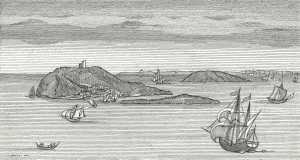 The first ferries to the islands, beginning in the eighteenth century, were the large rowing craft known as "pazar kayık". Small steam-powered ferries made their appearance in 1846, to be followed by larger steamboats when the Şirket-i Hayriye began regularly scheduled ferry service to the islands at the beginning of the second half of the nineteenth century. This led to a great increase in the population of the islands, both in the number of year-round residents and those with summer homes. There was also a huge influx of day-trippers and overnight visitors on weekends and holidays, which led to the erection of hotels on the larger islands, although there are fewer hostels now than there were in times past. The ferry service has been expanded in recent years, with high-speed sea buses going out to the islands from Kabataş on the Bosphorus in addition to the regular ferryboats from the Adalar station on the Golden Horn. Despite these developments, the archipelago is still largely unspoiled, particularly because automotive transport is banned, except for a few municipal vehicles. Otherwise the only means of transport on Burgazada, Heybeliada and Büyükada is by fayton, or horse-drawn carriage, while on Kınalıada one must either walk or ride a bicycle.
The first ferries to the islands, beginning in the eighteenth century, were the large rowing craft known as "pazar kayık". Small steam-powered ferries made their appearance in 1846, to be followed by larger steamboats when the Şirket-i Hayriye began regularly scheduled ferry service to the islands at the beginning of the second half of the nineteenth century. This led to a great increase in the population of the islands, both in the number of year-round residents and those with summer homes. There was also a huge influx of day-trippers and overnight visitors on weekends and holidays, which led to the erection of hotels on the larger islands, although there are fewer hostels now than there were in times past. The ferry service has been expanded in recent years, with high-speed sea buses going out to the islands from Kabataş on the Bosphorus in addition to the regular ferryboats from the Adalar station on the Golden Horn. Despite these developments, the archipelago is still largely unspoiled, particularly because automotive transport is banned, except for a few municipal vehicles. Otherwise the only means of transport on Burgazada, Heybeliada and Büyükada is by fayton, or horse-drawn carriage, while on Kınalıada one must either walk or ride a bicycle.
The Names of the Islands in History
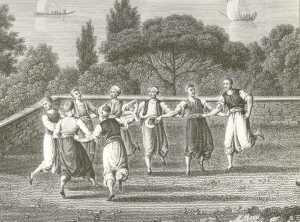 In antiquity the archipelago was called Demonisia, the People’s Isles. During Byzantine times the archipelago came to be known as Papadonisia, the Islands of the Monks, from the many monasteries that had been established on the various isles. The emperor Justin II (r. 565-78) built himself a palace and monastery on the largest of the islands in 569. This isle had been known as Megale, or the Great, but after the emperor established residence there it came to be called Prinkipo, the Isle of the Prince. Later the entire archipelago came to be called the Prinkiponisos, or the Princes’ Isles..
In antiquity the archipelago was called Demonisia, the People’s Isles. During Byzantine times the archipelago came to be known as Papadonisia, the Islands of the Monks, from the many monasteries that had been established on the various isles. The emperor Justin II (r. 565-78) built himself a palace and monastery on the largest of the islands in 569. This isle had been known as Megale, or the Great, but after the emperor established residence there it came to be called Prinkipo, the Isle of the Prince. Later the entire archipelago came to be called the Prinkiponisos, or the Princes’ Isles..
Büyükada - Prinkipo
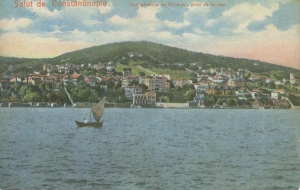 The island is rich in historical associations. The earliest of these concern the palace built in 569 by Justin II (r. 565-78), nephew and successor of Justinian (r. 527-65). According to the chronicler Kedrenos, Justin had a "farm estate" on the island, on which he built his palace and probably also a monastery. The name of the monastery is unknown, although it is believed to be the convent where several empresses of Byzantium and at least one emperor were confined during their periods of exile.
The island is rich in historical associations. The earliest of these concern the palace built in 569 by Justin II (r. 565-78), nephew and successor of Justinian (r. 527-65). According to the chronicler Kedrenos, Justin had a "farm estate" on the island, on which he built his palace and probably also a monastery. The name of the monastery is unknown, although it is believed to be the convent where several empresses of Byzantium and at least one emperor were confined during their periods of exile.
The palace and convent are believed to have been on the northeastern shore of the island in the district now known as Maden, or the "Mine," so called because of the iron mine that was worked there in the mid-nineteenth century. The archaeological evidence to support this includes a capital bearing a monogram with the name of the empress Sophia, wife of Justin II. Another capital with a monogram giving the name of the emperor himself was found in the present church of St. Dimitrios in the village of Büyükada.
Ernest Mamboury, in a paper published in 1943, reported on archaeological finds he made in the Maden district, in an area known as Kamares, or the "Arches," doubtless from the ruins that were then still visible there. Mamboury estimated that the convent occupied an area of about 300 square meters, its north and south wings each about 250 meters long, with the ruins of the conventual church still evident within the enclosure. However, these remains have now utterly disappeared.
The convent was rebuilt and enlarged by the empress Eirene (r. 797-802), one of the few women to rule Byzantium in her own right. Eirene was the wife of Leo IV (r. 775-80) and mother of his son and successor, Constantine VI (r. 780-97). Constantine was only ten when he succeeded to the throne, and so his mother Eirene was made regent and immediately began restoring icons to the churches of Byzantium, from which they had been banned by the iconoclastic policy of her late husband. Constantine took power in 790 and confined his mother to the palace, but he proved incapable of rule and two years later he released Eirene and crowned her as co-emperor. Then in 797 Eirene and her supporters overthrew Constantine, who was blinded by his mother and sent into exile in the convent that the empress had founded on Prinkipo. Constantine died a few days later and was buried in the graveyard of the convent.
Eirene thus became the first woman ever to rule the Byzantine Empire on her own, though her unnatural crime profoundly shocked Constantinople. As the chronicler Theophanes wrote: "And the sun was darkened during seventeen days, and gave not his light, so that ships ran off course, and all men said and confess that because the emperor was blinded, the sun had put away his rays. And in this way power came into the hands of Eirene, his mother."
Eirene ruled on her own for more than five years, but then on 31 October 802 she was deposed in a palace coup, to be succeeded by Nicephorus I (r. 802-11). Eirene was then exiled, first to her convent on Prinkipo and then to the island of Lesbos in the Aegean, where she died the following year. Her remains were brought back and buried in the graveyard of her convent on Prinkipo, laid to rest beside her son Constantine. Their graves were tended by the Princess Euphrosyne, who had been exiled to the convent with her father. Euphrosyne remained in the convent for twenty-seven years; she was finally released in 824 to become the bride of the recently widowed Michael II (r. 820-9), a usuper of plebian origins who married the princess to lend legitimacy to his reign.
The next imperial exile in the convent was the empress Zoe, daughter of Constantine VIII (r. 1025-8) and wife in turn of Romanus III Argyrus (r. 1028-34), Michael IV (r. 1034-41), and Constantine IX Monomachus (r. 1042-55). After the death of Michael IV the succession passed to Michael V (r. 1041-2), the adopted son of Zoe, who turned on his foster mother and exiled her to the convent on Prinkipo. This infuriated the people of Constantinople, who overthrew and exiled Michael, after which they raised Zoe and her younger sister Theodora to the throne. The sisters ruled as co-emperors for three months until they were succeeded by Constantine IX Monomachus (r. 1042-55), who married Zoe on 12 June 1042 and was crowned as emperor the following day.
When Isaac I Comnenus (r. 1057-9) was suffering through his last illness he tried to arrange for his younger brother John to be his successor. But when Isaac abdicated, the landowning military aristocracy passed over John in favor of one of their own, who was crowned as Constantine X Ducas (r. 1059-67). John Comnenus was then sent into exile on Prinkipo, where he was confined to a monastery, while his wife Anna Dalassena and their children took up residence in the convent that had been founded by the empress Eirene. After a few months John was allowed to leave Constantinople with his family and go into obscure retirement in a remote part of the empire, where he died in 1067. Anna bided her time until her eldest son succeeded to the throne as Alexius I Comnenus (r. 1081-1118). Alexius then crowned his mother as empress, and she was the power behind the throne until her death in 1102. When Alexius himself died in 1118 his wife, the empress Eirene Ducaena, retired to the convent on Prinkipo, where she died five years later, the last of the imperial exiles to be be consigned to the island.
Heybeliada - Halki
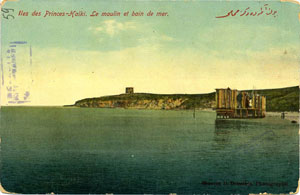
Halki, the Greek name of the island, which means "copper," comes from the copper mines that were worked here in antiquity, mentioned by Aristotle. The island took its Turkish name, Heybeli, from the word for saddlebag, heybe, which it is said to resemble because of the shape of its hills and their intervening valleys.
In Byzantine times, there were at least three monasteries on Heybeliada, then known as Halki. The most renowned of these was Hagia Triada, the Holy Trinity, whose site on Ümit Tepesi is occupied by the Greek Orthodox theological school of the same name, a direct descendant of the original Byzantine monastery. The present monastery is the most prominent monument on Heybeliada, dominating the view from an approaching ferry and from within the village itself.
The earliest reference to a monastery on Halki is in the writings of St. Theodore of Studius early in the ninth century. Theodore, abbot of Constantinople’s famous monastery of St. John of Studius, was exiled to a monastery on Halki by Leo V (r. 813-20) because of his criticism of the emperor’s iconoclastic policy. While on Halki, Theodore wrote a number of letters, theological treatises, and poems, one of which was addressed fondly to the monastic cell in which he was confined. Theodore does not name the monastery, but other evidence would seem to indicate that it was the Holy Trinity. Theodore’s letters say that after Leo V was assassinated in 820, his widow, the empress Theodora, and her daughters were exiled to the monastery on Halki by the new emperor, Michael II. Theodore and the other residents of the Holy Trinity were then evicted to make way for the empress and her daughters. Thus there would seem to have been another monastic establishment on Halki where the displaced monks could find shelter, and it has been suggested that this was the monastery of St. John the Baptist.
Burgazada - Antigoni
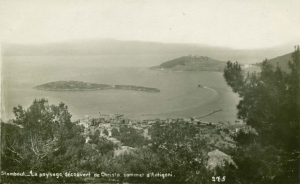 In antiquity the island was known as Panormos, but in Byzantine times it was called Antigoni, the name still used by the Greeks. The Turkish name of Burgaz is a corruption of the Greek pyrgos, or tower, from an ancient watchtower on its summit that is mentioned by Evliya Çelebi and other travelers up until the early nineteenth century. The watchtower can be seen on the summit of the island in an engraving done in 1794 by Cosimo Comidas. The engraving shows the island bare except for what appear to be an orchard and two or three cultivated patches on the side of the hill.
In antiquity the island was known as Panormos, but in Byzantine times it was called Antigoni, the name still used by the Greeks. The Turkish name of Burgaz is a corruption of the Greek pyrgos, or tower, from an ancient watchtower on its summit that is mentioned by Evliya Çelebi and other travelers up until the early nineteenth century. The watchtower can be seen on the summit of the island in an engraving done in 1794 by Cosimo Comidas. The engraving shows the island bare except for what appear to be an orchard and two or three cultivated patches on the side of the hill.
In more recent times, the island was densely wooded, principally with pines. Unfortunately, a fire in 2003 destroyed most of the trees above the village, but the area has been replanted with pine saplings.
The single hill, Hristos Tepesi (Christ Hill), also known as Bayraktepe (Flag Hill), rises to a height of 170 meters in the middle of the island. The center of the village is on the northeast coast of the island, its houses stretching from there along the heights above the northern shore. The shore roads extend around all of the island except its inhospitable south coast, where precipitous cliffs hang over the sea.
During Byzantine times there were at least two monasteries on the island, one of them dedicated to St. John the Baptist (Hagios Ioannis Prodromos), and the other to the Transfiguration of Christ, but neither seems to have housed any royal exiles.
The earliest reference to the monastery of St. John is in the diary of the Reverend John Covel, who in his entry for 2 May 1675 writes: "There hath been a monastery upon Antigono, but now it is decaid, and shrunk to a little church dedicated to St. John." Covel visited the island again on 2 April 1677, when he made the following entry in his diary: "That evening about 5 a clock, we set sail from Pera, and came to Antigono, where we lay in a poor tavern. The town is not worth any notice. The wine is ordinary...the water very bad; bread dear and not very good."
The only famous personage exiled on Antigoni during the Byzantine period was St. Methodios the Confessor, Patriarch of Constantinople (r. 842-6), who was imprisoned in the monastery of St. John by Michael II, the Stammerer, during the years 822-9 because of his opposition to the emperor’s policy of iconoclasm. After Michael’s death in 829 his son and successor, the emperor Theophilos (r. 829-42), released Methodios and allowed him to return to Constantinople. Methodios was elected patriarch in 842 and the following year he convened a Church Council that restored the veneration of icons, ending the Iconoclastic Period. After Methodios died in 846 he was canonized, his body having been laid to rest in the church of the Holy Apostles among the tombs of the Byzantine emperors.
Kınalıada - Proti
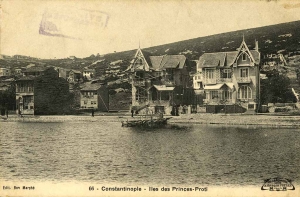 The Greeks have always called the island Proti, or First, since it is the nearest of the islands to the city. It is the smallest of the four major islands, with an area of 1.356 square kilometers.
The Greeks have always called the island Proti, or First, since it is the nearest of the islands to the city. It is the smallest of the four major islands, with an area of 1.356 square kilometers.
The Reverend John Covel, chaplain of the Levant Company in Galata, made two voyages out to the islands in 1676-7, and on the second of these he observed that the village on Proti had been destroyed and abandoned, though there is no record of what catastrophe might have been responsible for this. As Covel writes in his entry for 26 February 1677:
We left Chalcis [Halki]. We past by Antigono [Antigoni], and came to Prote [Proti]. There is no village there, but onely a monastery on the top dedicated to our Saviour, Haghios Sotir. They have all the island to themselves. There is no vineyards, it being most rocky barren ground. It is decimated, and hath a stavromenos [a monastery belonging to one on Mount Athos]. There are about ten or fifteen kaloyeri [monks]. They had a fine herd of goats, and then above thirty young kids in their mandra [enclosure for cattle]. There are good olives, flax, and some corn ground. There is on the east side going up a pond, but the water is not good or lasting all the year, proceeding onely from the rain or snow, and not regarded or preserved as a cistern. On that side there hath been a town, but all is now level’d with the ground. On these islands there are wells or cisternes, and as good water as can be drunk.
The monastery described by Covel is one of several known to have been founded on Proti in Byzantine times. The one that he describes was dedicated to the Transfiguration of the Saviour (Metamorphoseos tou Sotiros) and housed several distinguished exiles, including a number of emperors and empresses of Byzantium.
The first of these exiles was the Armenian general Bardanes, who in 803 revolted against the emperor Nicephorus I (r. 802-11). The army proclaimed Bardanes emperor and he advanced upon Constantinople, but as his troops approached the capital they began deserting to Nicephorus. Bardanes was persuaded to surrender to Nicephorus, who had him blinded and exiled to Proti, where he spent the rest of his days as a monk, perhaps in a monastery that he founded himself.
The emperor Michael I Rhangabe (r. 811-13) was deposed by his Armenian general Leo, who succeeded to the throne as Leo V (r. 813-20). Leo sent Michael off into exile to the monastery of the Transfiguration on Proti. Michael was accompanied in his exile by his wife, the empress Procopia, and their four children, two daughters and two sons. Procopia and her daughters took the habit as nuns, while Michael and his two sons, Theophylact and Nicetas, became monks, the two boys being castrated so that they could never succeed their father as emperor. Michael died on Proti in 840 and was buried in the monastery graveyard. Nicetas, who took the name Ignatius when he became a monk, eventually was allowed to leave Proti and served two terms as patriarch of Constantinople (847-58, 867-77); after his death he was canonized as a saint in the Orthodox Church.
Leo was assassinated in 820 by Michael the Amorian, who succeeded to the throne as Michael II. Michael then exiled Leo’s widow, Theodosia, and her four children to the monastery of the Panagia, or Holy Virgin, on Proti, where the remains of the deposed emperor were buried.
Romanus I Lecapenus (r. 919-44), an Armenian, was overthrown on 17 December 944 by his sons Stephen and Constantine, who then had themselves crowned as co-emperors and sent their father into exile in the monastery of the Transfiguration on Proti. But then on 27 December Stephen and Constantine were themselves deposed and sent off into exile at the same monastery. Romanus died there on 15 June 948, while Stephen and Constantine were subsequently sent off into more distant exile on an island in the Aegean, where they were confined in a monastery for the rest of their days.
Romanus II (r. 959-63) scandalized Byzantium by marrying a beautiful courtesan named Theophano. When Romanus died in an accident in 963 Theophano married his successor, Nicephorus II Phocas (r. 963-9), an Armenian general. Six years later Theophano and her lover John Tzimisces, another Armenian general, conspired to assassinate Nicephorus, whom they killed on 10 December 969. The following day Tzimisces was crowned as the emperor John I (r. 969-76). Theophano thought that he would marry her and that she would become an empress for the third time, but Tzimisces exiled her to a monastery on Proti, where she remained for the rest of her life.
Romanus IV Diogenes (r. 1067-71) was deposed in 1071 after his catastrophic defeat by the Seljuk Turks at the battle of Manzikert. His successor, Michael VII Doucas (r. 1071-8), blinded Romanus and exiled him to the monastery of the Transfiguration on Proti, where he died on 4 August 1072.
Kınalıada has three peaks, with Çınar Tepesi (Plane Tree Hill) rising in the northeast of the island to an elevation of 115 meters, Teşrifiye Tepesi (110 m.) in the center, and Manastır Tepesi (93 m.) in the south. All three hills are almost treeless but are covered with brush, just as they appear in an engraving of the island done in 1794 by Cosimo Comidas. The engraving shows two of the hills crowned with large structures which are undoubtedly monasteries, one of them overshadowed by an enormous cypress. Teşrifiye Tepesi is now studded with a dozen television and communications antennae, an unsightly reminder that the modern world has penetrated these once idyllic isles.
Kınalıada is the most barren of the four major islands, as Grosvenor notes in his description of its appearance, where he interprets its topography in terms of two hills rather than three and gives it three monasteries:
Proti, the First or Nearest, consists of two prolonged and lofty mounds. A belt of trees spans the hollow. No water-springs refresh its bare and arid surface. Stunted shrubbery and a few straggling houses cling like moss along the slopes. Its very appearance is suggestive of the sorrows and tragedies it has seen, all accomplished within the walls of three monasteries between which the island was shared.
Sedefadası - Antirovithos
The name of the island is said to derive either from sedef (mother-of-pearl) or from sedefotu, the rue plant commonly found here.
St. Ignatius founded a monastery for men on Antirovithos in the mid-ninth century, one of three monastic establishments he built on the Princes’ Isles, all of which are mentioned in the list made by Manuel I Comnenus in 1158. The monastery on Antirovithos was restored in 1180 by the patriarch Theodosius Boradiotis. All that remains of the monastery today is a fragmentary ruin on the northwestern promontory of the island.
During the reign of Mahmut II (r.1808-39) the island was given over to the sultan’s son-in-law, Rodosizade Damat Fethi Ahmet Paşa, who planted two thousand olive trees and five thousand artichoke plants.
The Smaller Islands
Sivriada - Oxia
Despite its small size, Oxia (Sivriada) had its monastery, of which some remnants have survived. This establishment is mentioned in the list of monasteries compiled in 1158 by the emperor Manuel I Comnenus. The monastery had two churches: a katholikon of the Archangel Michael and a chapel dedicated to a number of martyred saints. Several abbots of the monastery subsequently became patriarch of Constantinople. Substantial ruins of the monastery can still be seen on the hillside beside the quay on the inner side of the port.
The earliest mention of the island in Ottoman times is by Petrus Gyllius, who stopped there in 1545. The island’s chief fame in modern times is that on several occasions all the wild dogs of Istanbul were rounded up and exiled there, where they soon ate each other up.
Yassıada - Plati
Yassıada measures 300 by 190 meters, with a maximum elevation of forty meters. It too had its monastery, founded in the mid-ninth century by St. Ignatius, who was twice patriarch of Constantinople (847-58, 867-77). The monastery, mentioned by Manuel I Comnenus in his listing of 1158, had a katholikon dedicated to the Forty Martyrs and also a chapel of the Virgin. Ernest Mamboury, writing in his 1943 guide to the Princes’ Isles, reports that he found remnants of one of these churches, whose ruins now seem to have vanished.
Sir Henry Bulwer, British ambassador to the Sublime Porte, purchased Yassıada in 1857 with the intention of developing it as a market garden. At the time his mistress was Eurydice Aristarchi, Princess of Samos, for whom he erected what Mamboury calls a chateau moyennageux (medieval chateau), where Bulwer and his entourage were popularly believed to have indulged in "nameless orgies.
Kaşıkadası - Pita
Kaşıkadası is the smallest of the nine islands of the archipelago and its highest point a mere eighteen meters above sea level. It has no known history, and it was the only isle in the archipelago that did not have a monastery in Byzantine times.
Tavşanadası - Neandros
Small though it is, Neandros was the site of a monastery, founded in the mid-eighth century by St. Ignatius, son of the emperor Michael I and twice patriarch of Constantinople, who spent his last years in his monastery on Neandros, where he died and was buried in 877. The monastery is mentioned in the list made in 1158 by Manuel I Comnenus. The empress Theodora, wife of the emperor Theophilus (r. 829-42), was confined to the monastery on Neandros in 856 by her son Michael III (r. 842-67), the Sot, for whom she had served as regent until he came of age. Michael VII Doucas (r. 1071-8) was confined to the monastery after he was deposed and blinded in 1078, and he remained there until his death in 1090. The fragmentary ruins of the monastery can still be seen on the island, which is totally uninhabited.
Vordonosadası - Vordonosi
Tiny though it is, it too was the site of a Byzantine monastery, founded in the second half of the ninth century by the patriarch Photius.
From the Voyagers' Journals
- Details
- Created on 17 February 2013
- Last Updated on 01 April 2013
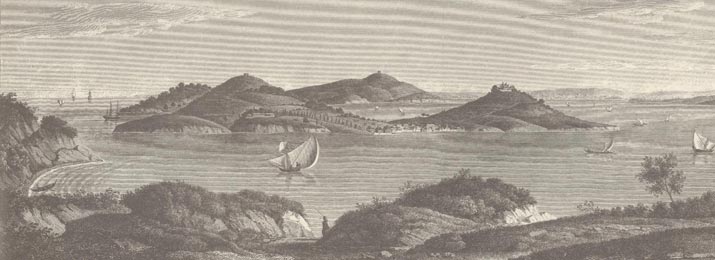
The Turkish chronicler Evliya Çelebi, author of the Seyahatname, or Chronicle of Travels, writes of two voyages that he and his companions made to the islands in 1640 (AH 1050), the first of which took them from the Bosphorus to Heybeli on their way to Bursa:
We weighed anchor at Emirgan on the Bosphorus, and called at F›nd›kl› to take on board as passengers some clever ship-builders; and in the morning on the first Friday of Moharrem of the year 1050, the boatmen finding the time favorable for sailing, unfurled the sails and weathered Seraglio Point; laying the ship’s head toward Bursa, the object of our voyage. All the passengers were in high spirits, and some of them implored the Lord’s assistance for a happy voyage by singing spiritual songs. Some musicians encourged me to accompany them in their strains, and so...I fixed on the measure girdanieh, and sang three tetrasticks and one sumayi of the compositions of Dervish Omerbestieh. Some of the boatmen accompanied us on their instruments, chokur, with such effect, that water came into the mouths of the hearers with delight. Amidst these amusements we came to the isle of Heybeli, eighteen miles from Constantinople and nine in circumference. It contains a famous convent which is visited every year by many boats from Constantinople. The inhabitants are all wealthy Greeks, captains and masters of ships....
Evliya’s estimate of the circumference of Heybeliada is far too large, an exaggeration he also makes in giving the sizes of the other isles in describing another voyage he made later that same year:
 “We embarked for the island of Heybeli... which we have already mentioned. Six miles farther on is the island of Tavshanli [Rabbit or Hare Istand], which derives its name from the infinite number of hares found there; it is only one mile in circumference, and is uncultivated. After rowing eight miles we came to the island of Burgaz with a small but strong castle, situated on the chalk cliff by the seashore. The island is eleven miles in circumference, and... it has three hundred houses with fine gardens and good wells.... The inhabitants are all Greeks, and are rich masters of boats. The island abounds in goats and hares. Kınalı is eight miles in circumference, has a convent and a village of one hundred Greek houses. Ten miles distant from it is Büyükada, a cultivated island twenty miles in circumference, with a village of two hundred Greek houses. On its four sides there are dalyans, lookouts for catching fish.
“We embarked for the island of Heybeli... which we have already mentioned. Six miles farther on is the island of Tavshanli [Rabbit or Hare Istand], which derives its name from the infinite number of hares found there; it is only one mile in circumference, and is uncultivated. After rowing eight miles we came to the island of Burgaz with a small but strong castle, situated on the chalk cliff by the seashore. The island is eleven miles in circumference, and... it has three hundred houses with fine gardens and good wells.... The inhabitants are all Greeks, and are rich masters of boats. The island abounds in goats and hares. Kınalı is eight miles in circumference, has a convent and a village of one hundred Greek houses. Ten miles distant from it is Büyükada, a cultivated island twenty miles in circumference, with a village of two hundred Greek houses. On its four sides there are dalyans, lookouts for catching fish.
The beauty of the Princes’ Isles and the rather grim historical associations of its royal exiles appealed to the romantic imagination of the nineteenth century. This aspect of the islands is evoked in a purple passage at the beginning of Gustave Schlumberger’s charming book Les Iles des Princes, first published in 1884:
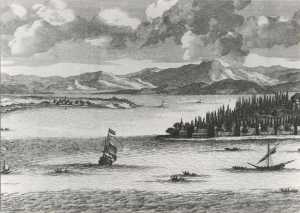 "Naples has its Capri and its Ischia: Constantinople its Princes’ Isles. The Neapolitan is not more proud of the jewels that adorn his bay than is the Greek of Pera of his charming islands, places of repose and pleasure, that raise their enchanting silhouettes at the entrance to the Sea of Marmara. Just as the crimes of Tiberius almost as much as the splendors of nature have made Capri famous, so the gloomy adventures of emperors, empresses and all the exiles of high rank, relegated to the convents of Proti, Antigoni, and Prinkipo as well as a result of the revolutions with which the history of Byzantium bristles, have made these radiant islands one of the most tragic sites of the ancient world. No corner of the earth is more fertile in stories of lamentable catastrophes, in poignant lessons in the vanity of human grandeur. From this point of view alone the Princes’ Isles would deserve a visit from the historian and the thinker. Few places here below have witnessed the groans of more princes and princesses hurled from the splendors of the Imperial Palace to the depths of a cell in some imperial monastery. Add to these moving souvenirs the fact that this archipelago in miniature possesses beauties designed to ravish an eye sated with the marvels of Italy and Sicily, that nowhere does the delighted eye repose on coasts more lovely, on a bay more gracious, on mountainous distances more grandiose; that nowhere is the verdure fresher or more varied; that nowhere in short do bluer waters bathe more gently a thousand shady coves, a thousand poetic cliffs; you will then understand why the Princes’ Isles, bedewed of yore with so many tears, vaunted today with so much praise, are a favorite place of pilgrimage for all those who are attracted by the study of a dramatic past or the charm of a smiling present.
"Naples has its Capri and its Ischia: Constantinople its Princes’ Isles. The Neapolitan is not more proud of the jewels that adorn his bay than is the Greek of Pera of his charming islands, places of repose and pleasure, that raise their enchanting silhouettes at the entrance to the Sea of Marmara. Just as the crimes of Tiberius almost as much as the splendors of nature have made Capri famous, so the gloomy adventures of emperors, empresses and all the exiles of high rank, relegated to the convents of Proti, Antigoni, and Prinkipo as well as a result of the revolutions with which the history of Byzantium bristles, have made these radiant islands one of the most tragic sites of the ancient world. No corner of the earth is more fertile in stories of lamentable catastrophes, in poignant lessons in the vanity of human grandeur. From this point of view alone the Princes’ Isles would deserve a visit from the historian and the thinker. Few places here below have witnessed the groans of more princes and princesses hurled from the splendors of the Imperial Palace to the depths of a cell in some imperial monastery. Add to these moving souvenirs the fact that this archipelago in miniature possesses beauties designed to ravish an eye sated with the marvels of Italy and Sicily, that nowhere does the delighted eye repose on coasts more lovely, on a bay more gracious, on mountainous distances more grandiose; that nowhere is the verdure fresher or more varied; that nowhere in short do bluer waters bathe more gently a thousand shady coves, a thousand poetic cliffs; you will then understand why the Princes’ Isles, bedewed of yore with so many tears, vaunted today with so much praise, are a favorite place of pilgrimage for all those who are attracted by the study of a dramatic past or the charm of a smiling present.
Edwin Grosvenor gives an equally impassioned description of the islands and their lugubrious history in his Constantinople, published in 1895:
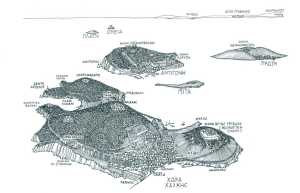 Nature, insatiable in giving, has diversified the capital not only with the Bosphorus and the Golden Horn, but with the tiny archipelago of the Princes’ Isles. More than Ischia and Capri are to Naples, are Khalki, Prinkipo and their sister islands to Constantinople. They are far less remote from the municipal centre, and form an integral part of the city. The nearest is but four miles distant from Kadikeui, and only little farther from Stamboul.
Nature, insatiable in giving, has diversified the capital not only with the Bosphorus and the Golden Horn, but with the tiny archipelago of the Princes’ Isles. More than Ischia and Capri are to Naples, are Khalki, Prinkipo and their sister islands to Constantinople. They are far less remote from the municipal centre, and form an integral part of the city. The nearest is but four miles distant from Kadikeui, and only little farther from Stamboul.
They were anciently called Demonesoi, from a legendary or historic Demonesos, who worked in their stone and metal. Their mediaeval name, Papadanesoi, the islands of the Priests, and the modern name, Princes’ Isles, through the irony of history, have a common meaning and association. During the Byzantine Middle Ages, the monastery was not far distant from the throne. He who, in the evening, wore the imperial golden circlet upon his long and plaited locks might on the morrow, with shaven head, become the unwilling inmate of a monastic cell. In those days, the islands were seldom sought for pleasure, but were abandoned to monasteries and monks. Hither many a deposed sovereign was exiled, whom, stripped of all that made life desirable, the disdain or humanity of his successor permitted to live. Not one of all the discarded emperors imprisoned here, with cowl and cloak, ever went back to his throne. Though almost all the monasteries have crumbled, and only a few inmates wander over the grass-grown paths, the tradition of deposed princes has survived and bestowed upon the islands their present name.
 They are nine in number. Two, Pita and Neandros, are destitute of inhabitant or interest. Three, Oxeia, Pita and Antirovithos, are isolated from the present, but have each their history of failure and sorrow. Four, Proti, Antigone, Khalki, and Prinkipo, are the chief. They are in daily steam communication with one another and with the other quarters of the capital. The mildness and regularity of their climate render them the healthiest locality in the Empire. Nowhere else along the northern Marmora does the olive tree grow with such profusion, or yield more generous results. Nothing more ideal can be pictured than the loveliness of these islands in May and June. The hills are covered with pine forests, and the meandering shores are indented with shaded and sequestered bays. Wherever the gaze is turned, beauty confronts the eye. Yet in winter they are almost deserted. The treacherous Marmora suddenly and often cuts off all communication with the outer world. Then, though at sunset the shadow of Stamboul seems to fall upon them, they are practically many leagues away.
They are nine in number. Two, Pita and Neandros, are destitute of inhabitant or interest. Three, Oxeia, Pita and Antirovithos, are isolated from the present, but have each their history of failure and sorrow. Four, Proti, Antigone, Khalki, and Prinkipo, are the chief. They are in daily steam communication with one another and with the other quarters of the capital. The mildness and regularity of their climate render them the healthiest locality in the Empire. Nowhere else along the northern Marmora does the olive tree grow with such profusion, or yield more generous results. Nothing more ideal can be pictured than the loveliness of these islands in May and June. The hills are covered with pine forests, and the meandering shores are indented with shaded and sequestered bays. Wherever the gaze is turned, beauty confronts the eye. Yet in winter they are almost deserted. The treacherous Marmora suddenly and often cuts off all communication with the outer world. Then, though at sunset the shadow of Stamboul seems to fall upon them, they are practically many leagues away.
Scattered in the sea southeast of the Bosphorus, their rounded forms present a vision of delight. Looked upon from the west, the four chief islands lie spread upon the horizon as if blent in one. Still nearer on the right, Oxeia the Lofty lifts its towering, cone-like rock; while Plati the Flat emerges little above the surface of the water.
The Princes’ Isles are still as beautiful and romantic as Schlumberger and Grosvenor describe them, floating in the mirroring water off the Asian coast of the Marmara between the pale blues of sea and sky, places of refuge and exile from the turbulent megalopolis on the Bosphorus.
Those Who Left Marks on the Princes' Islands
- Details
- Created on 19 February 2013
- Last Updated on 01 April 2013
Eirene; Byzantium's First and Only Empress Was Exiled to Büyükada
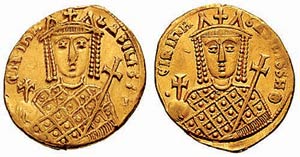 The empress Irene was the first and only female sovereign of Byzantium but she had been dethroned and arrested following a palace coup. Then, 1209 years ago, escorted by armed guards, she was taken to the convent on Büyükada.?Irene was locked away in a cell. As she?gazed from the window facing Sedefadası (Terebinthos), she felt the irony ofher situation. She was the one who had commissioned theconstruction of this convent, but now she was imprisoned in it. Sometime later, she was secretly exiled to Midilli Island (Lesbos).Irene did not survive for long.
The empress Irene was the first and only female sovereign of Byzantium but she had been dethroned and arrested following a palace coup. Then, 1209 years ago, escorted by armed guards, she was taken to the convent on Büyükada.?Irene was locked away in a cell. As she?gazed from the window facing Sedefadası (Terebinthos), she felt the irony ofher situation. She was the one who had commissioned theconstruction of this convent, but now she was imprisoned in it. Sometime later, she was secretly exiled to Midilli Island (Lesbos).Irene did not survive for long.
Her last wish was, “Lay my body to rest in the Saint Nicholas Chapel to the left of the Virgin Mary Church at the monastery I built with my sorrowful and suffering heart on Prinkipo Island (Büyükada) in the sight of God.” And that is what they did.
M. Kemal Atatürk
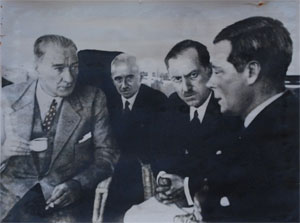 Atatürk visited Büyükada’yı ve Anadolu Club frequently. He met important state persons. Notable guests have included Atatürk and Ismet Inönü as well as foreign heads of state: Elefterios Venizelos, Prime Minister of Greece (1924); King Amanullah Han of Afghanistan (1930); King Carol of Romania and Madame Lupescu (1933); General Metaxas, the Greek dictator (1936); Shah Riza Pahlavi of Iran (1964); and Nikolau Ceausescu, the Romanian dictator (1976). When Atatürk visited the club he stayed in Room 25, which is preserved as it was in his time. In the garden of the club there is a monument to Atatürk, dedicated in 1981 to mark the centenary of his birth. The club cannot be visited, but one can observe the beautiful buildings and grounds from the gateway.
Atatürk visited Büyükada’yı ve Anadolu Club frequently. He met important state persons. Notable guests have included Atatürk and Ismet Inönü as well as foreign heads of state: Elefterios Venizelos, Prime Minister of Greece (1924); King Amanullah Han of Afghanistan (1930); King Carol of Romania and Madame Lupescu (1933); General Metaxas, the Greek dictator (1936); Shah Riza Pahlavi of Iran (1964); and Nikolau Ceausescu, the Romanian dictator (1976). When Atatürk visited the club he stayed in Room 25, which is preserved as it was in his time. In the garden of the club there is a monument to Atatürk, dedicated in 1981 to mark the centenary of his birth. The club cannot be visited, but one can observe the beautiful buildings and grounds from the gateway.
Fethi Okyar
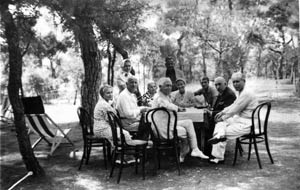 Ali Fethi Okyar had been a close friend of Mustafa Kemal Atatürk since their childhood. Fethi Okyar- soldier, diplomat, MP and minister- became the leader of the opposition the Free Republic Party, established in 1930 with Atatürk’s approval and support. But in the same year, finding it impossible to continue the party, he retreated to his house on Büyükada.
Ali Fethi Okyar had been a close friend of Mustafa Kemal Atatürk since their childhood. Fethi Okyar- soldier, diplomat, MP and minister- became the leader of the opposition the Free Republic Party, established in 1930 with Atatürk’s approval and support. But in the same year, finding it impossible to continue the party, he retreated to his house on Büyükada.
İsmet İnönü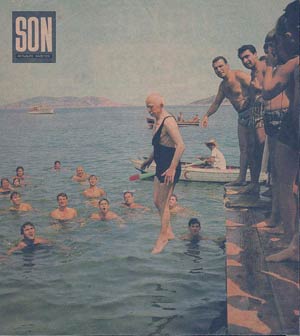
Ismet Inonu, first Turkish Prime Minister and later President of the Turkish Republic. Ismet Inönu, first rented the house originally known as the Mavromatakis Köşku on Heybeliada, as a summer home in 1924, when he recuperated there after an illness. The Inönus bought the house in 1934 for 9,500 liras, with new furniture presented to them as a gift by Atatürk. Eventually the family decided to have the house preserved as a museum under the Inönu Foundation, restored just as it was when Ismet Paşa moved there in 1937.
Yesari Asım Arsoy
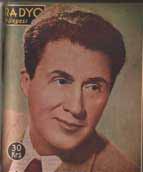 "Biz Heybeli’de her gece mehtaba çıkardık" In a little park next to the Naval High School there is a statue of Yesari Asim Arsoy (1896-1992), famous as the composer of a song celebrating Heybeli
"Biz Heybeli’de her gece mehtaba çıkardık" In a little park next to the Naval High School there is a statue of Yesari Asim Arsoy (1896-1992), famous as the composer of a song celebrating Heybeli
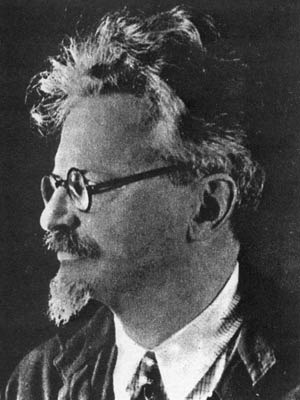
Lev Trotsky
Lev Davidovich Trotsky, one of the leaders of the Soviet Revolution, came to Istanbul when forced into exile by Stalin in 1929 and spent most of his four-year stay in Istanbul on Büyükada.
Trotsky left Büyükada on 17 July 1933, never to return. Despite his isolation on the island he seems to have enjoyed his exile there, as evidenced by the last entry he made in his notebook on the day he departed: "It has been four and one-half years. I have the strange feeling of having my feet firmly planted on Büyükada."
Label on the Famous Kulüp Rakısı

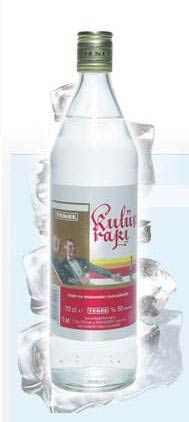 Ihap Hulusi Görey, a graphic designer and painter, and Fazıl Ahmet Aykaç, a poet, author, teacher and MP, both from Kınalıada, were close friends. They got together from time to time on their island and sometimes at the Büyükada Anatolian Club.
Ihap Hulusi Görey, a graphic designer and painter, and Fazıl Ahmet Aykaç, a poet, author, teacher and MP, both from Kınalıada, were close friends. They got together from time to time on their island and sometimes at the Büyükada Anatolian Club.
His label for the famous Kulüp Rakısı--the label still used today--shows two very stylish, handsome gentlemen drinking raki. They are said to be Fazıl Ahmet Aykaç and Ihap Hulusi himself, pictured drinking at the Anatolian Club. With this label, designed in 1932, the famous artist immortalised their friendship.
Lefter Küçükandonyadis
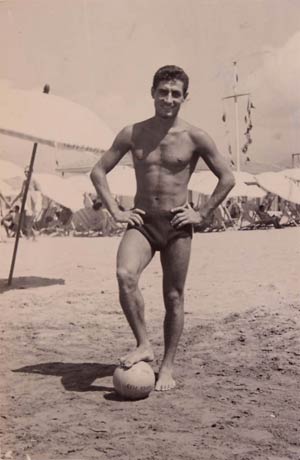 Lefter Küçükandonyadis played first for Taksimspor. After his military service, at age 21, he signed with Fenerbahçe, where he scored 407 goals in 605 games. He was the first footballer to wear the national jersey 50 times, scoring 22 goals in international games. Lefter, still a football legend, is now 86 years old and lives on Büyükada.
Lefter Küçükandonyadis played first for Taksimspor. After his military service, at age 21, he signed with Fenerbahçe, where he scored 407 goals in 605 games. He was the first footballer to wear the national jersey 50 times, scoring 22 goals in international games. Lefter, still a football legend, is now 86 years old and lives on Büyükada.
Mina Urgan
“Trotsky used to live in a residence on Nizam Street at Büyükada, with a garden?that stretched all the way to the shore. He never walked about in the streets, but went fishing on his boat almost every day. One day, when I was swimming offshore I recognized Trotsky’s boat. We were be able to identify this boat from afar, because there were two Russian bodyguards on the bow and stern.?In the middle sat the Greek fisherman?that pulled the oars and Trotsky holding?his fishhook. I quickly swam towards the?boat and held onto the side and practically came face to face with Trotsky. One of the bodyguards said ‘Go, go.’ (Actually he said ‘Go, go’ with a Russian accent.) I wanted to use my fatigue as an excuse to hold on so I could watch Trotsky a bit longer.”
Mina Urgan,
The Memories of a Dinosaur
Ziya Gökalp
Yahya Kemal persuaded his friend, Ziya Gökalp (1876-1924), to move to Büyükada. After Gökalp came, Turkish nationalist intellectuals such as Ahmet Ağaoğlu, Hamdullah Suphi, Celal Sahir, Necmettin Sadık and Fuat Köprülü began to gather on Büyükada.?Gökalp’s illness worsened in 1924 he was taken to Büyükada from Nişantaşı. While he was ill on the island, he edited his book, Türk Medeniyet Tarihi.
He resided at: Fatma Hurrem House, Albayrak Sokağı (Maden) No:17?. Rotenberg Mansion, Çankaya Caddesi Albayrak Sokak (Maden) No: 6
Melih Cevdet Anday
 Melih Cevdet Anday, one of the most important poets in Turkish literature, penned the often-quoted line about the island, “Ada vapuru yandan çarklı...”. Anday was one of the founders of the Garip movement of poetry and the philosophical poetic movement. UNESCO considered him to be a writer as important as Cervantes, Dante and Tolstoy. He wrote articles and essays in newspapers under both his real name and penname and also did translations. His poems, essays, criticisms, plays and novels received many awards. He spent the last years of his life on Büyükada and he is buried on the island.
Melih Cevdet Anday, one of the most important poets in Turkish literature, penned the often-quoted line about the island, “Ada vapuru yandan çarklı...”. Anday was one of the founders of the Garip movement of poetry and the philosophical poetic movement. UNESCO considered him to be a writer as important as Cervantes, Dante and Tolstoy. He wrote articles and essays in newspapers under both his real name and penname and also did translations. His poems, essays, criticisms, plays and novels received many awards. He spent the last years of his life on Büyükada and he is buried on the island.
The Fisherman of Halicarnassus
Halikarnas Balıkçısı (1890-1973), whose real name was Cevat Şaki Kabaağaçlı, completed his primary education on Büyükada. While he attended Robert College, he spent his summers at Rosola Mansion on Büyükada, together with his large family.
Yahya Kemal Beyatlı
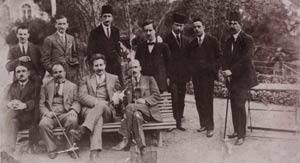 Yahya Kemal Beyatlı (1884-1958) came to Büyükada in 1913 upon the recommendation of Tahsin Nahid and stayed in a fine, pleasant room on the top floor of the Savoy Hotel, with a window facing the street . He also stayed at the Splendid Hotel for a short period. The following year, when he returned to Büyükada, he rented a mansion with Yakup Kadri on Azaryan Yokuşu, with a sea view, two bedrooms, a kitchen at the back and a maid’s room.
Yahya Kemal Beyatlı (1884-1958) came to Büyükada in 1913 upon the recommendation of Tahsin Nahid and stayed in a fine, pleasant room on the top floor of the Savoy Hotel, with a window facing the street . He also stayed at the Splendid Hotel for a short period. The following year, when he returned to Büyükada, he rented a mansion with Yakup Kadri on Azaryan Yokuşu, with a sea view, two bedrooms, a kitchen at the back and a maid’s room.
In addition to his duties at Darülfünun (University), Kemal served as a history teacher at the Heybeliada Naval Academy. Nâzım Hikmet and Necip Fazıl Kısakürek were students of Kemal’s during this period.
Nurullah Ataç
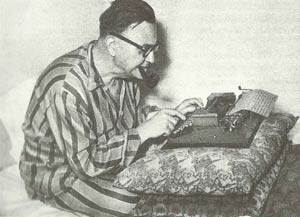 Nurullah Ataç (1898-1957), one of the limited number of authors who only wrote criticisms and essays during the Republic period, was an admirer of the Islands. To him, Büyükada was Istanbul. He rarely went to the city. He complained about not being able to write in Istanbul. Shortly after his daughter Meral was born, Nurullah Ataç settled on Büyükada with his family. Meral Ataç Tolluoğlu sincerely describes her memories of her father and Büyükada in her book, Babam Nurullah Ataç:
Nurullah Ataç (1898-1957), one of the limited number of authors who only wrote criticisms and essays during the Republic period, was an admirer of the Islands. To him, Büyükada was Istanbul. He rarely went to the city. He complained about not being able to write in Istanbul. Shortly after his daughter Meral was born, Nurullah Ataç settled on Büyükada with his family. Meral Ataç Tolluoğlu sincerely describes her memories of her father and Büyükada in her book, Babam Nurullah Ataç:
“In terms of nature, the island is far more beautiful in winter than summer. The inhabitants of the island are like kith and kin. Everybody knows each other, greet each other and ask after each other. To live in such a place gives people both happiness and trust. Also, my uncle and his family live here both in summer and winter. After my father and mother thought about it, they decided to settle on the Island again after they moved.”
From Babam Nurullah Ataç
He resided at: Ataç House Lonca Sokağı No:24
Reşat Nuri Güntekin
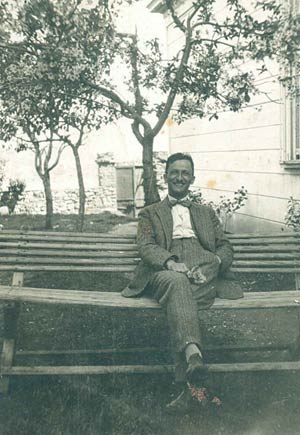 Reşat Nuri Güntekin (1889-1956), the author of Çalıkuşu, one of the most widely read novels in Turkish literature, settled on Büyükada in the 1930’s with his family because he liked living in quiet places. He hosted his relatives more often than his writer friends; he hosted dinner for them, as they played on the swings in the garden. His daughter, Ela Güntekin, who came to Büyükada when she was only a few months old, spent time with her father as they walked and chatted. For many years, the family spent their summers on the island.
Reşat Nuri Güntekin (1889-1956), the author of Çalıkuşu, one of the most widely read novels in Turkish literature, settled on Büyükada in the 1930’s with his family because he liked living in quiet places. He hosted his relatives more often than his writer friends; he hosted dinner for them, as they played on the swings in the garden. His daughter, Ela Güntekin, who came to Büyükada when she was only a few months old, spent time with her father as they walked and chatted. For many years, the family spent their summers on the island.
His novel, Akşam Güneşi, expresses his feelings about Büyükada.
Büyükada, House of Reşat Nuri Güntekin, Museum of the Princes’ Islands Archive
Hüseyin Rahmi Gürpınar
 Hüseyin Rahmi Gürpınar (1864-1944) lived in a rental house for 10 years in the 1900’s. He bought land from Hıdiv Abbas Paşa and built the Gürpınar Mansion, where he lived until his death. The three-storied mansion on Heybeliada looks towards Burgazada, and from the sea, three sides of the house can be seen, far from town, high up a steep slope in a forested area. He is buried here.
Hüseyin Rahmi Gürpınar (1864-1944) lived in a rental house for 10 years in the 1900’s. He bought land from Hıdiv Abbas Paşa and built the Gürpınar Mansion, where he lived until his death. The three-storied mansion on Heybeliada looks towards Burgazada, and from the sea, three sides of the house can be seen, far from town, high up a steep slope in a forested area. He is buried here.
Hüseyin Rahmi describes his life on Heybeliada in Kokotlar Mektebi and mentions the island in Sevda Peşinde and Tebessüm-i Elem
He resided at: Gürpınar Mansion, Demirtaş Sokağı No: 19
Aziz Nesin
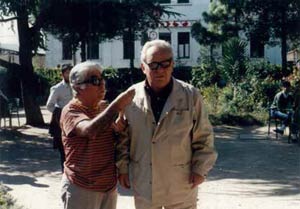 Aziz Nesin (1915-1995) is one of the writers born on the Islands. Nesin lived on Heybeli until he was 10 years old and wrote about the Heybeli of his childhood and the residents in a lively and detailed manner in Böyle Gelmiş Böyle Gitmez.
Aziz Nesin (1915-1995) is one of the writers born on the Islands. Nesin lived on Heybeli until he was 10 years old and wrote about the Heybeli of his childhood and the residents in a lively and detailed manner in Böyle Gelmiş Böyle Gitmez.
“There was only one mosque in Heybeliada: (...) The muezzin of the islands mosque Feyyaz had a serious speech defect, he stammered. He used to talk with great difficulty. But the voice of this stutterer was really beautiful. And he never stammered when he was reciting the call for prayers or chanting the Prophet Mohammed’s nativity hymn. (...) Briefly, we had to discover means to live cheap and find ways to live on a very small amount of money. There were cisterns in most of the houses, because there were no water resources on the island. We did not have a reservoir in our small house. And we could not get water from the peddling watermen who stacked water on to back of their donkeys. Because we did not want to spend money. Me and my sister – but mostly my sister – used to carry water from the fountain at the port side area in a copper churn.”
From Istanbul Boy: The Autobiography of Aziz Nesin.
Zeyyat Selimoğlu
 When mentioning Heybeliada, Zeyyat Selimoğlu (1922-2000) is one of the names that immediately come to mind. Selimoğlu translated many books into Turkish, mostly dealing with ships and the different lives of people who live/work on ships. The book Direğin Tepesinde Bir Adam attracted much attention when it was first published. All of his stories about the sea are collected in the book Gemi Adamları.
When mentioning Heybeliada, Zeyyat Selimoğlu (1922-2000) is one of the names that immediately come to mind. Selimoğlu translated many books into Turkish, mostly dealing with ships and the different lives of people who live/work on ships. The book Direğin Tepesinde Bir Adam attracted much attention when it was first published. All of his stories about the sea are collected in the book Gemi Adamları.
Ahmet Rasim
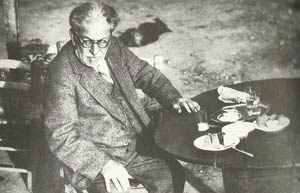 Ahmet Rasim (1865-1932) settled on Heybeliada after living in Kadıköy and he spent the last days of his life here. He wrote about the islands in his quick and extremely entertaining style.
Ahmet Rasim (1865-1932) settled on Heybeliada after living in Kadıköy and he spent the last days of his life here. He wrote about the islands in his quick and extremely entertaining style.
Kitabe-i Gam is Rasim’s letter novel written for a beautiful woman whom he knew and loved on the Island.
He resided at: Ahmet Rasim House, Heybeliada, Hüseyin Rahmi Sokağı No: 25/1
Sait Faik Abasıyanık
 Sait Faik Abasıyanık (1906-1954) wrote about the Islands, the fishermen and the fish and is identified with Burgazada. He spent most of the last ten years of his life in the mansion at 15 Çayır Sokak.?The mansion was converted into a museum upon the will of his mother, Makbule Abasıyanık, and the Sait Faik Abasıyanık Museum was opened by the “Burgazadası’nı Güzelleştirme Derneği (The Beautification of Burgazadası Association)” on 22 August 1959. The maintenance and restoration responsibilities of the museum are met by the Darüşşafaka Cemiyeti (Darüşşafaka Association).
Sait Faik Abasıyanık (1906-1954) wrote about the Islands, the fishermen and the fish and is identified with Burgazada. He spent most of the last ten years of his life in the mansion at 15 Çayır Sokak.?The mansion was converted into a museum upon the will of his mother, Makbule Abasıyanık, and the Sait Faik Abasıyanık Museum was opened by the “Burgazadası’nı Güzelleştirme Derneği (The Beautification of Burgazadası Association)” on 22 August 1959. The maintenance and restoration responsibilities of the museum are met by the Darüşşafaka Cemiyeti (Darüşşafaka Association).
Sait Faik and Burgazada are inseparable. One will always be associated with the other and one is incomplete without the other.
He resided at: Sait Faik House, Çayır Sokağı No: 15
Halide Edip Adıvar
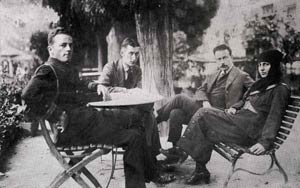 Halide Edip Adıvar (1884-1964), one of the most important writers in Turkish literature, is among those who settled on Burgazada to escape the noise of Istanbul. Her home, Zafiriadis House, with a rose garden and covered by wisteria, held a special place in her heart.
Halide Edip Adıvar (1884-1964), one of the most important writers in Turkish literature, is among those who settled on Burgazada to escape the noise of Istanbul. Her home, Zafiriadis House, with a rose garden and covered by wisteria, held a special place in her heart.
Some parts her novel, Raik’in Annesi, are set on Burgaz. She resided at: Zafiriadis House, Mehtap Sokağı No: 43
Fazıl Ahmet Aykaç
 Fazıl Ahmet Aykaç (1884-1967), whose humor and witty conversations are often quoted, is a symbol of Kınalıada. He brought important innovations to the fields of humour and poetry. He imitated many of the famous poets and poems of the period, which made him a much talked about figure.
Fazıl Ahmet Aykaç (1884-1967), whose humor and witty conversations are often quoted, is a symbol of Kınalıada. He brought important innovations to the fields of humour and poetry. He imitated many of the famous poets and poems of the period, which made him a much talked about figure.
He hosted many of his friends at his house on Kınalıada. İhap Hulusi memorialized their friendship and their conversations in the raki label he drew for Kulüp Rakısı. Naşide Görey, İhap Hulusi’s wife, tells the story of the creation of the label:
“For that Tekel raki, he developed compositions in his mind, drew sketches, tried a few models, but he was not satisfied. Meanwhile, his close friend Fazıl Ahmet Aykaç was watching him. İlhap Bey turned and said; “Fazıl, come and sit here!’ and he came and sat before him. Thus, that famous label of Kulüp Rakısı was created and has been used since that day for over half a century.”
He resided at:?. Civanyan House, Çandarlı Sokağı No: 9?. Ağasi House, Fazıl Ahmet Aykaç Caddesi No: 23
Zabel Asadur
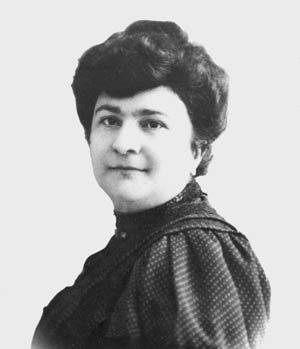 Lawyer and writer Hrand Asadur (1862-1928) and his well-known writer and poet wife, Zabel Asadur (1863-1924, nee Hancıyan), lived in a four-storied wooden house on Kınalıada known as the Derunyan house.
Lawyer and writer Hrand Asadur (1862-1928) and his well-known writer and poet wife, Zabel Asadur (1863-1924, nee Hancıyan), lived in a four-storied wooden house on Kınalıada known as the Derunyan house.
Zabel Asadur, whose goal when she was sixteen was to open schools and orphanages for the education and training of Armenian girls in Anatolia, established “Azkanıver Hayuhyats Ingerutyun” (Nationalist Armenian Women’s Association) and wrote about the problems of women in her articles published?in Masis magazine under the penname “Sibil”. She devoted herself to the liberalization of women. Asadur, who wrote for periodicals in Armenian and translated from French, also served at the Esayan and Getronogan schools as an Armenian teacher.
Zahrad
 Zahrad, whose real name was Zareh Yaldızcıyan (1924-February 21, 2007), lived on Kınalıada for many years. His first book of poetry, Büyük Şehir, was published in 1960 and translated into twenty-five languages. The poetry of this globally known poet were translated into Turkish by caricaturist, Ohannes Şaşkal and published in three anthologies: Yağ Damlası, Yapracığı Gören Balık, Işığını Söndürme.
Zahrad, whose real name was Zareh Yaldızcıyan (1924-February 21, 2007), lived on Kınalıada for many years. His first book of poetry, Büyük Şehir, was published in 1960 and translated into twenty-five languages. The poetry of this globally known poet were translated into Turkish by caricaturist, Ohannes Şaşkal and published in three anthologies: Yağ Damlası, Yapracığı Gören Balık, Işığını Söndürme.
For Zahrad, who put forward the feeling of space in his poems, Istanbul was always the island.
Yakup Kadri Karaosmanoğlu
“We were endowed with the opportunity to spend the most beautiful, most enthusiastic and the merriest of those days in Büyükada owing to the hospitality of our friends Tahsin Nahit and his wife. I said ‘Tahsin Nahit and his wife’s hospitality’. Because their house at Maden became a meeting place for us and a center of attraction. Tahsin Nahit was above all known as the poet of the Islands, island pines and island fullmoons. His wife, on the other hand was born and raised in Büyükada and I can freely say that it was this couple who taught us the beauty of the island, and also who made us love it.”
Yakup Kadri Karaosmanoğlu,
Memoirs of Youth and Literature
Transportation In and Between Islands
- Details
- Created on 17 February 2013
- Last Updated on 13 May 2013
Upon Arrival
In case you have heavy luggage you may ask some help from the carriers on the Pier. They can take your luggage to your house/hotel.
You should ask about the fee in advance. Prices change depending on on the load and destination.
Transportation in Islands
Phaeton (Horse carriage)
You can find the Phaeton terminal near the Piers at Büyükada, Heybeliada and Burgazada. It is compulsary that the price list should be hanged in the terminal and in the Phaetons. Please ask the prices in adavance...
Transportation Between Islands
Please look at the schedules. You may use Mavi Marmara boats or Şehir Hatları ferries between islands.
Getting to the Beaches
In all islands special boat services are available for transportation to the beaches. These boats can be found near the main piers.
In general, transportation fee is included in the entrance fee. You can also use the same boats for your return.
Bicycle
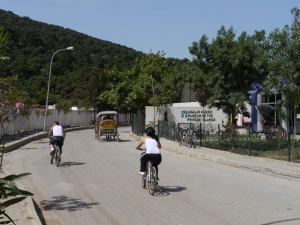 You can rent bicycles from around the center of the islands.
You can rent bicycles from around the center of the islands.
Please ask about the rules of renting and driving the bicycle and follow them carefully. Do not allow this delightful trip to become a nightmare for yourself and others.
Rent a Boat or Yacht at Adalar
Phones, Useful Web Sites...
Transportation to Museum of The Princes' Islands
Museum of the Princes’ Islands is the first contemporary city museum of Istanbul. It tells the story of the Islands from the geological formation of the Islands to the present day, displaying hundreds of objects and utilising twenty thousand Ottoman archival documents, six thousand digital photographs, hundreds of documentary films, documentation and filming of today’s Islands, archival records of public institutions of the Islands, temporary and permanent donations of the Islanders.
You can reach the Museum by walk (about 20 minutes from Center) by bicycle or by phaeton.
Taking Pets to Islands
You may take your pets and tour together in Islands. However you should follow the rules in the means of transport. You should have your pet in a cage and mouth collar. Your pet may travel only in open areas of the boats. Also you should bring a bag to collect the excrement of your pet.
Note to interested: In Büyükada there is a dog shelter at Aya Nikola Square near Museum of the Princes' Islands. There you may find several dogs abondened in the forest. Want to vis,t them? (Please see the map)
How to get to the Islands?
- Details
- Created on 18 February 2013
- Last Updated on 08 May 2013
By sea of course.
There are scheduled trips from both sides of Istanbul everyday of the year.
From the European side: Big boats take off mainly from Kabataş and from eminönü from time to time, the City Lines' traditional boats and IDO's catamarans organize regular trips to the Islands.
From the Asian side: Big boats take off mainly from Bostancı and additionally from Kartal and Maltepe. The City Lines' traditional boats are also available from Bostancı.
Furthermore you can call on a seataxi from either side of the Bosphorus. Even though you will wait for a while and that the prices are not at the same level as the regular boat trips, the seataxis will take you to the islands in a relatively short span of time.
As for the transportation on the islands there are a few different options. You will either choose to walk or hop on a horse carriage, if not you can always rent a bike. If you want to go to another neighbouring island ou can do so by taking one of the boats owned by private companies or the City Lines.


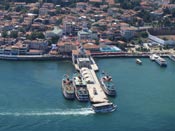
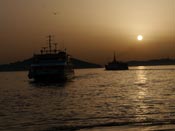
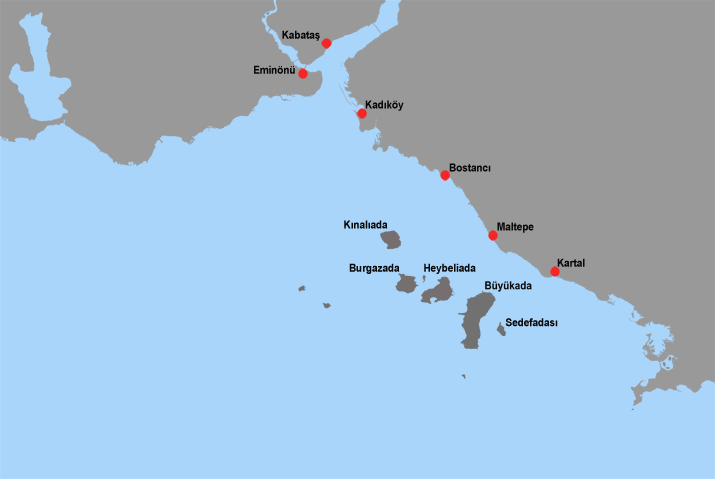
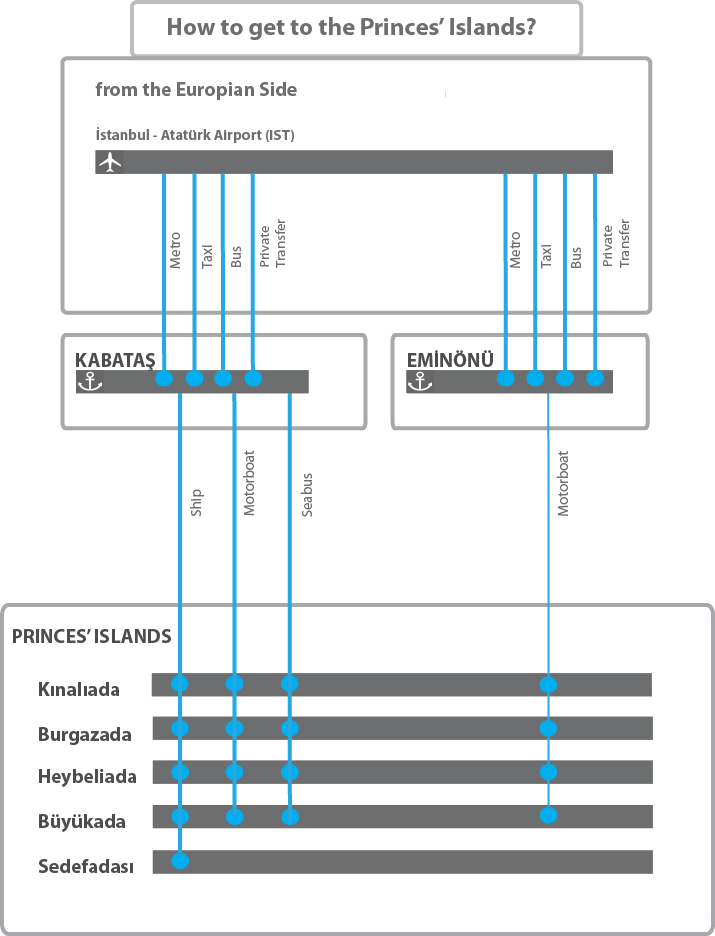
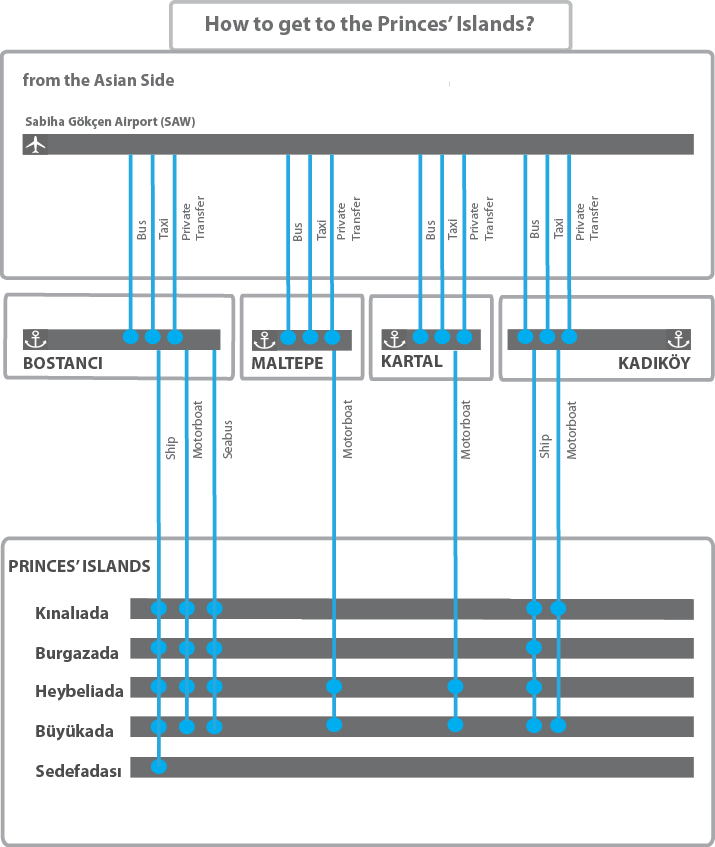
European Side:
If you have landed at the Istanbul Atatürk Airport, depending on the traffic, it will take you between 45 and 90 minutes to get to Kabataş by car. Alternatively you can make use of the City's public transportation system and get to Kabataş by using the subway, funicular, tram and buses. If you have just missed the boat at your arrival you can always relax and enjoy a cup of tea at the shore.
Kabataş is a big harbor. Where you find the IDO catamarans, the City Lines' boats and other piers of various sizes side by side. It is possible to get to many different destinations in Istanbul by sea. Timetables are shown on each pier. You can look at these timetables to get to the Islands. Or you can click here to learn more about the scheduled trips.
Asian Side:
You can fetch a bus ride from the Sabiha Gökçen Airport to bostancı organized by Havaş and havataş. Bostancı, is a central harbour to reach many places in Istanbul including the Islands. The City Lines, Mavi Marmara and IDO piers are all lined along the coastline. The schedules can be found on the piers. Alternatively you can learn the timetable by clicking on the link below.
TRANSPORTATION SCHEDULES
Here you can find the schedules of the boat rides depending on your point of departure and arrival.
These timetables change twice a year. Different schedules are organized during winter and summer. There also may be temporary changes to these schedules depending on the weather conditions
We aim at giving you only the most up to date schedules. Nonetheless we suggest that you check the cmpanies' websites for the earliest and latest boat rides from and to the Islands.
COMPANIES
Mavi Marmara : http://www.mavimarmara.net/
City Lines : http://www.sehirhatlari.com.tr
İDO : http://www.ido.com.tr/
Dentur : http://www.denturavrasya.com/
Prenstur : http://www.prenstur.net/
Turyol : www.turyol.com
SEATAXI
You can order a private boat from the seataxis any time of the day. During the busy summer season it may take a bit longer for the seataxis to arrive at your point of departure. Please ask for the time of arrival and the price for the fair, the first time you call the seataxi.
Süvari Seataxi
İDO Seataxi
Private boat reservationfor groups larger than 10:
Mavi Marmara
A small hint:
If you sit on the right side of the boat while coming to the islands you may enjoy the view of our archipelago during all your trip..
CONTACT INFORMATION
| Organization | Phone | Fax | Web | |
| City Lines Head Office | +90 212 313 80 00 | +90 212 253 94 75 | www.sehirhatlari.com.tr | This email address is being protected from spambots. You need JavaScript enabled to view it. |
| City Lines Kabataş | +90 212 444 18 51 | |||
| City Lines Büyükada | +90 216 382 60 06 | |||
| City Lines Heybeliada | +90 216 351 84 37 | |||
| City Lines Burgazada | +90 216 381 13 17 | |||
| City Lines Kınalıada | +90 216 381 40 20 | |||
| City Lines Customer Services | 444 18 51 | |||
| İDO Head Office | +90 212 455 69 00 | +90 212 517 39 58 | www.ido.com.tr | This email address is being protected from spambots. You need JavaScript enabled to view it. |
| İDO Kabataş | +90 212 243 56 12 | |||
| İDO Bostancı | +90 216 410 66 33 | |||
| İDO Büyükada | +90 216 382 44 36 | |||
| İDO Heybeliada | +90 216 351 15 03 | |||
| İDO Burgazada | +90 216 381 28 40 | |||
| İDO Customer Sevices | 444 44 36 | |||
| Mavi Marmara Customer Services | 444 20 39 | www.mavimarmara.net | This email address is being protected from spambots. You need JavaScript enabled to view it. | |
| Mavi Marmara Bostancı | +90 216 464 29 30 | |||
| Turyol Centre | +90 212 251 44 21 | +90 212 251 96 74 | www.turyol.com | This email address is being protected from spambots. You need JavaScript enabled to view it. |
| Turyol Eminönü | +90 212 527 99 52 | |||
| Museum of Princes' Islands | +90 216 382 64 30 | +90 216 382 58 42 | www.adalarmuzesi.org | This email address is being protected from spambots. You need JavaScript enabled to view it. |
| Islands Municipality | +90 216 382 3 382 | +90 212 381 76 61 | www.adalar.bel.tr | This email address is being protected from spambots. You need JavaScript enabled to view it. |
| İDO Seataxi | 444 44 98 | |||
| İDO Seataxi Head Office | +90 212 615 62 62 | +90 212 616 54 24 | www.deniztaksi.com.tr | This email address is being protected from spambots. You need JavaScript enabled to view it. |
| M.Marmara D.T.Süvaribey Boat | +90 545 445 72 80 | |||
| M.Marmara D.T.Mavimarmara Boat | +90 545 445 72 72 | |||
| Heybeliada S.Ü.Kooperatifi (Liman) | +90 216 351 96 30 | +90 212 351 83 73 | ||
| Heybeliada Couch Station | +90 216 35113 90 | |||
| Heybeliada Porter Head (Mehmet Yıldız) | +90 536 263 82 95 | |||
| Büyükada Coach Stattion | +90 216 382 59 39 |
Biking
- Details
- Created on 16 July 2014
- Last Updated on 30 July 2014
 The best biking routes of İstanbul are on the Islands. Since motor vehicle traffic is prohibited on the Islands except public vehicles, this makes an ideal environment for biking. Roads are between mansions, houses with gardens and not more than two stories and all in green space. Most of the sections of the roads suitable for biking are in forests or on the coast with beautiful scenery. Allies and paths in the forests are suitable for both mountain bikes and ordinary ones.
The best biking routes of İstanbul are on the Islands. Since motor vehicle traffic is prohibited on the Islands except public vehicles, this makes an ideal environment for biking. Roads are between mansions, houses with gardens and not more than two stories and all in green space. Most of the sections of the roads suitable for biking are in forests or on the coast with beautiful scenery. Allies and paths in the forests are suitable for both mountain bikes and ordinary ones.
You can rent a bike on the Islands as you can carry your own bike. There are many bike renting points close to piers and centers of Büyükada, Heybeliada, Burgazada and Kınalıada. You can rent bike hourly or daily. Although it may change, price for hourly rent is 10TL and for daily rent is 20 TL. You can get discount from these prices according to age of bike, please ask before renting.
Attention: Although Islands are suitable for biking, on weekends, roads on all Islands, especially on Büyükada have very heavy phaeton, bike and passenger traffic and this causes increasing of accidents.
lease always ask for helmet when renting bike. Do not drive fast. Be careful especially while driving downhill. Try to be away from crowded roads. Don’t forget that there are many roads with beautiful scenery in the forests. You can find these roads on the maps, available for sale around piers.
Phaeton
- Details
- Created on 16 July 2014
- Last Updated on 31 July 2014
Motor vehicles are not used for transportation on the Islands. Motor vehicles are mainly allowed for public services such as cleaning, health, ambulance, police, fire department etc. Public transportation on Büyükada, Heybeliada and Burgazada are done by means of phaetons.
There are Phaeton-stops close to centers of every three islands. Usage of phaetons starts at 6:00 am and continues up to 12:00 am. It is also possible to find phaetons when the last boats reach to Islands.
Phaetons give service according to price list approved by UKOME, related to Adalar Municipality and İstanbul Metropolitan Municipality. Phaetons must carry printed price list. Please ask for price list when you get into phaeton. If you meet a driver without price list or who does not apply regular prices, please inform them with their license plate numbers to municipal officers or policeman.
Phaeton Tours
Phaeton tours are very attractive on these three islands for local and international visitors. It is an opportunity not to be missed, if you visit Islands.
Recommended Phaeton Tours:
Büyükada
Small Tour: It mainly covers residential areas of the Island. It takes 35 minutes including break given at Luna Park Area.
Big Tour: You go around all Büyükada with this tour. It also covers south coast of the Island, full of maquis with beautiful forest and sea view. It takes about 60 minutes including break given at Luna Park Area.
Heybeliada
You go around all Island with this tour. Most of it is in forest and with sea view. It takes about 45 minutes.
Burgazada
Its route is between Burgazada Center and Kalpazankaya.
Practical Information
- Details
- Created on 17 February 2013
- Last Updated on 01 April 2013
Health
Medical Emergencies:
Büyükada has a hospital and health clinic. Each of the other islands has a clinic, and Heybeliada also has a polyclinic specializing in chest ailments. Büyükada Hospital has eight doctors, including four specialists. Heybeliada’s polyclinic has a team of medical specialists, and the other islands’ clinics are staffed by general practitioners. During the summer months, the clinics have practitioners on duty around the clock. Each island has ambulance service within the island, and an ambulance boat is available for emergency transport to the mainland.
Telephone numbers:
Büyükada State Hospital: (216) 382 62 28
Büyükada Health Clinic: (216) 382 62 10
Heybeliada Health Clinic: (216) 351 88 50
Burgazadası Health Clinic:: (216) 381 19 19
Kınalıada Health Clinic: (216) 381 40 60
Pharmacies:
There are drugstores on the four main islands: Büyükada, Heybeliada, Burgazadas›, and K›nal›ada. Weekday hours are 08.00-18.30 in winter and 08.00-20.00 in summer. Each island has one pharmacist on duty for emergencies at night and on Sundays and official holidays. The name of the pharmacist on duty is posted in the window of all pharmacies.
Tipping
A five to fifteen percent tip is customary for staff at hotels, restaurants, Turkish baths and hairdressers.
Post Office, Telephone and Internet Services
Post and Telephone:
Post offices can be identified by the letters PTT on a yellow background. The PTT also provides telephone, telegram, and fax services. Büyükada’s main post office, on Recep Koç Caddesi, is open twenty-four hours a day, seven days a week. On other islands, the post office follows government office hours.
The telephone area code for the Princes’ Islands is 0216, same as the Asian side of Istanbul. The code for the European side of Istanbul is 0212.
Internet:
There are Internet cafes on Büyükada and Heybeliada. On Büyükada: near Çınar Meydanı. On Heybeliada: just off Lozan Zaferi Caddesi, at Erkal Sok. No. 1/A and Işgüzar Sok. No. 12
Newspapers, Magazines and Books
There are newspaper and magazine kiosks on the four main islands; the one on Büyükada, opposite the Yap› Kredi Bank, has some publications in English, French, and German. Also on Büyükada, a bookstore at the entrance to the ferry landing stocks books and periodicals, including many about the Princes’ Islands.
Banks
Many of the leading Turkish banks have branches on Büyükada and Heybeliada. Most of them have ATM machines.
Büyükada - Two Monasteries on Two Hills
- Details
- Created on 05 April 2013
- Last Updated on 12 July 2016
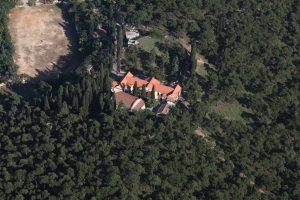 There are monasteries on both of the island’s hilltops, and there is a third on the eastern shore below Yüce Tepe, the southern peak. All three monasteries are accessible from the meydan at the waist of the island, to which one can take a fayton from the village.
There are monasteries on both of the island’s hilltops, and there is a third on the eastern shore below Yüce Tepe, the southern peak. All three monasteries are accessible from the meydan at the waist of the island, to which one can take a fayton from the village.
Isa Tepesi, the northern peak, is crowned with the monastery of the Transfiguration (Hagios Sotiros Christou). On the way up to the monastery one passes a huge wooden structure that once served as the Greek Orphanage, now abandoned and falling into ruins.
The monastery of St. George Koudonas crowns Yüce Tepe, the southernmost of the island’s two hills. A path leads up to the monastery from the meydan at the waist of the island.
The Monastery of the Transfiguration
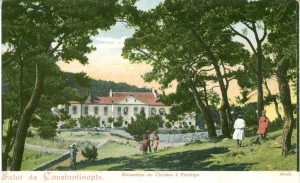 According to tradition, the monastery was founded in the Byzantine era, and implicit reference to it seems to have been made in a chrysobull issued in 1158 by the emperor Manuel I Comnenus.
According to tradition, the monastery was founded in the Byzantine era, and implicit reference to it seems to have been made in a chrysobull issued in 1158 by the emperor Manuel I Comnenus.
The monastery fell on hard times later in the Ottoman period, but it withstood these difficulties through the support of the guild of the Greek linseed oil merchants in Istanbul and an endowment from the Feneriote nobleman Pascharnikos Christodoulos Vlachoutsis. Patriarch Gregory V lived there in 1809; the former patriarch Chrysanthos moved to the monastery when he retired in 1826 and died there eight years later. Patriarch Sophronius was in residence during the years 1866-70, and through his efforts the monastery was restored and the present katholikon completed in 1869, in accordance with plans drawn by the architect Vasilis Dimitriou.
What remains of the monastery are its katholikon and an adjacent two-storey wing on its south, as well as some out-buildings on the western part of its grounds. The katholikon preserves the carved wooden iconostasis from the earlier church, gilded and decorated with floral and plant designs in both low and high relief. The doors of the Oraia Pylai are particularly notable, with eight small icons in their panels, the most remarkable being a depiction of the Annunciation, all dating from the eighteenth century. There is also a fine eighteenth-century Offertory Diptych, with Christ in the traditional Deesis representation atop the panels, flanked by the Virgin and St. John the Baptist. Set into the south exterior wall there is a replica of an ancient Greek funerary relief, dating from the second half of the nineteenth century.
The Greek Orphanage
 It is Europe’s largest wooden building, and the second largest in the world, according to Jak Deleon. The building was erected in 1898 by a French company, who planned to open it as a grand hotel called the Prinkipo Palas, with a gambling casino on the style of Monte Carlo. But Sultan Abdül Hamit II refused to give permission for such an establishment and it never opened. The building was then purchased by Eleni Zarifi, widow of the banker Leonidas Zarifi, who donated it to the Ecumenical Patriarchate on condition that it be used as an orphanage. The Greek Orphanage, which had been at Balıklı in Istanbul, reopened here in 1903, helped by a gift of 146 gold pieces donated by Abdül Hamit II, who also gave it tax-exempt status. The orphanage closed in 1964 and has since fallen into ruins, though it is still a most impressive site, one of the principal landmarks of Büyükada as seen from the sea.
It is Europe’s largest wooden building, and the second largest in the world, according to Jak Deleon. The building was erected in 1898 by a French company, who planned to open it as a grand hotel called the Prinkipo Palas, with a gambling casino on the style of Monte Carlo. But Sultan Abdül Hamit II refused to give permission for such an establishment and it never opened. The building was then purchased by Eleni Zarifi, widow of the banker Leonidas Zarifi, who donated it to the Ecumenical Patriarchate on condition that it be used as an orphanage. The Greek Orphanage, which had been at Balıklı in Istanbul, reopened here in 1903, helped by a gift of 146 gold pieces donated by Abdül Hamit II, who also gave it tax-exempt status. The orphanage closed in 1964 and has since fallen into ruins, though it is still a most impressive site, one of the principal landmarks of Büyükada as seen from the sea.
The Monastery of St. George Koudonas
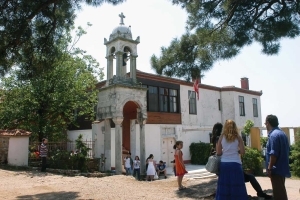 The monastery of St. George Koudonas crowns Yüce Tepe, the southernmost of the island’s two hills. A path leads up to the monastery from the meydan at the waist of the island.
The monastery of St. George Koudonas crowns Yüce Tepe, the southernmost of the island’s two hills. A path leads up to the monastery from the meydan at the waist of the island.
According to tradition, the monastery was founded in 963, during the reign of Nicephorus II Phocas (r. 963-9). The earliest reference to it is in the chrysobull of 1158 by Manuel I Comnenus mentioned earlier. The name Koudonas, which in Greek means "of the bells," comes from the story that a shepherd was grazing his flock on this hill when he heard the sound of bells coming from beneath the ground; when he dug down he found an icon of St. George, which he and other locals enshrined on the spot. This story is traditionally dated to the year 1625, and it probably represents the refounding of the monastery rather than a new foundation. Legend aside, the first abbot of record, Isaias, started building the present katholikon in 1752 and completed the main church of the Blachernitissa seven years later, also adding a number of monastic cells. Several additions were made in the following half century by the abbots Anthemios and Arsenios. Meanwhile a number of miracles were attributed to the icon of St. George, which was especially effective in curing mental ailments and in exorcizing those "driven by unclean spirits."
The present complex consists of six separate churches and chapels on three different levels, the older sanctuaries being on the lower levels. On the ground floor are the abbot’s house and the main church of St. George, both built early in the twentieth century. On the southern interior wall of the church is the original icon of Hagios Georgios Koudonas, now clad in silver. On a corner of the icon is a much later inscription, a moving appeal by a young Greek woman, who writes, "Dear St. George, help me go to Athens and study pharmacology."
A flight of steps leads to the first level below. Just beside the steps is a chapel of the Virgin Blachernitissa. Beyond that is another chapel of St. George, where iron rings set into the wall indicate that this was the place where mental patients were confined in the hope that they would be cured by the wonder-working icon of Hagios Georgios Koudonas. The room at the bottom of the stairs is a tiny shrine with an hagiasma, supposedly the place where the sacred icon of St. George was excavated. Beyond that is another chapel, dedicated to the Holy Apostles.
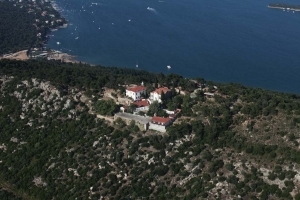 The feast day of St. George is celebrated on 23 April when thousands of pilgrims from around the world—including Muslim Turks and other non-Christians—make their way to the monastery, many of them walking barefoot up the hill to attend the dawn service. After the service many of the pilgrims have lunch at the little outdoor restaurant on the hilltop, celebrating the day that traditionally marks the beginning of spring according to the old calendar. The restaurant serves simple meals and snacks, as well as its own unlabled red wine. The hilltop is embowered in pines, cypresses, and other trees in a setting reminiscent of the Greek isles, particularly when the bells of the monastery are ringing in this ancient shrine.The feast day of St. George is celebrated on 23 April when thousands of pilgrims from around the world—including Muslim Turks and other non-Christians—make their way to the monastery, many of them walking barefoot up the hill to attend the dawn service. After the service many of the pilgrims have lunch at the little outdoor restaurant on the hilltop, celebrating the day that traditionally marks the beginning of spring according to the old calendar. The restaurant serves simple meals and snacks, as well as its own unlabled red wine. The hilltop is embowered in pines, cypresses, and other trees in a setting reminiscent of the Greek isles, particularly when the bells of the monastery are ringing in this ancient shrine.
The feast day of St. George is celebrated on 23 April when thousands of pilgrims from around the world—including Muslim Turks and other non-Christians—make their way to the monastery, many of them walking barefoot up the hill to attend the dawn service. After the service many of the pilgrims have lunch at the little outdoor restaurant on the hilltop, celebrating the day that traditionally marks the beginning of spring according to the old calendar. The restaurant serves simple meals and snacks, as well as its own unlabled red wine. The hilltop is embowered in pines, cypresses, and other trees in a setting reminiscent of the Greek isles, particularly when the bells of the monastery are ringing in this ancient shrine.The feast day of St. George is celebrated on 23 April when thousands of pilgrims from around the world—including Muslim Turks and other non-Christians—make their way to the monastery, many of them walking barefoot up the hill to attend the dawn service. After the service many of the pilgrims have lunch at the little outdoor restaurant on the hilltop, celebrating the day that traditionally marks the beginning of spring according to the old calendar. The restaurant serves simple meals and snacks, as well as its own unlabled red wine. The hilltop is embowered in pines, cypresses, and other trees in a setting reminiscent of the Greek isles, particularly when the bells of the monastery are ringing in this ancient shrine.
The view from the summit of Yüce Tepe is superb, encompassing all of the Princes’ Isles and the Asian shore of the Sea of Marmara, a prospect duly praised by Grosvenor, although the villages that he mentions have now all been amalgamated into the urban sprawl of Istanbul:
The view from this peak is the most extensive which Constantinople affords. From the height of six hundred and seventy feet the eye sweeps over the sea and comprehends the eastern shores of the Marmora. Northwest, beyond the island group, the fairy outline of Stamboul and Kadikeui fringes the sky, while the sombre point of Phanaraki advances in the foreground. North and east along the sinuous Asian coast, village presses upon village, each enriching the landscape with the tints of natural beauty or association.
Büyükada - Center
- Details
- Created on 18 February 2013
- Last Updated on 11 April 2013
The Ferry İskele
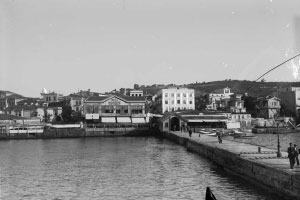 The lead-domed terminal building of the regular ferry, distinguished by its octagonal passenger hall, was designed in 1899 by the architect Mihran Azaryan of Izmit and completed in 1915. The tile revetment was made by Mehmet Emin Efendi of Kütahya. The upper floor was used as a cafe in the years 1918-23; from 1923-50 it was the District Office of the Republican Party’s Adalar (Islands) branch; in 1950-51 it housed the island’s first indoor cinema. The building was restored in 1999-2000, when Çelik Gülersoy of the Turkish Touring and Automobile Club created an elegant cafe on the upper floor, with a large balcony commanding a view of the Asian shore of the Marmara, an ideal spot to take refreshments before or after touring the island.
The lead-domed terminal building of the regular ferry, distinguished by its octagonal passenger hall, was designed in 1899 by the architect Mihran Azaryan of Izmit and completed in 1915. The tile revetment was made by Mehmet Emin Efendi of Kütahya. The upper floor was used as a cafe in the years 1918-23; from 1923-50 it was the District Office of the Republican Party’s Adalar (Islands) branch; in 1950-51 it housed the island’s first indoor cinema. The building was restored in 1999-2000, when Çelik Gülersoy of the Turkish Touring and Automobile Club created an elegant cafe on the upper floor, with a large balcony commanding a view of the Asian shore of the Marmara, an ideal spot to take refreshments before or after touring the island.
Büyükada - Important Villas and Mansion Houses You Can Encounter During Short Tour And Grand Tour Which You Can Do With A Coach Or Bicycle
- Details
- Created on 05 April 2013
- Last Updated on 11 April 2013
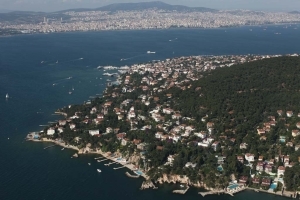 The street on the left side of the square leads to Fayton Meydanı, where all the horse-drawn carriages wait to be hired. The standard routes for visitors are the Büyük Tür (Grand Tour), a complete circuit of Büyükada, and the Küçük Tür (Short Tour), which does only the northern half, cutting across the waist of the island between Isa Tepesi and Yüce Tepe.
The street on the left side of the square leads to Fayton Meydanı, where all the horse-drawn carriages wait to be hired. The standard routes for visitors are the Büyük Tür (Grand Tour), a complete circuit of Büyükada, and the Küçük Tür (Short Tour), which does only the northern half, cutting across the waist of the island between Isa Tepesi and Yüce Tepe.
Büyükada - Luna Park Meydanı
- Details
- Created on 05 April 2013
- Last Updated on 11 April 2013
The Monastery of St. Nicholas
 The monastery of St. Nicholas (Hagios Nikolaos) is on the eastern shore of the island, accessible by both the shore road and another road leading from the meydan below the summit of Yüce Tepe. The monastery is on or near the site of the Byzantine settlement of Karyes, which was abandoned in the seventeenth century after being devastated in a fire. The earliest mention of the monastery is by the English traveller Thomas Smith in 1680. The original katholikon of the monastery may have been built on and from the ruins of the parish church of Karyes. In 1783 the monastery temporarily housed a "School for Greek Classes," which subsequently was relocated near the Patriarchate in Istanbul as the Megale Scole, or Great School, which is still in existence.
The monastery of St. Nicholas (Hagios Nikolaos) is on the eastern shore of the island, accessible by both the shore road and another road leading from the meydan below the summit of Yüce Tepe. The monastery is on or near the site of the Byzantine settlement of Karyes, which was abandoned in the seventeenth century after being devastated in a fire. The earliest mention of the monastery is by the English traveller Thomas Smith in 1680. The original katholikon of the monastery may have been built on and from the ruins of the parish church of Karyes. In 1783 the monastery temporarily housed a "School for Greek Classes," which subsequently was relocated near the Patriarchate in Istanbul as the Megale Scole, or Great School, which is still in existence.
When the Greek War of Independence began in 1821 the monastery was taken over by the Turkish Army. Later it was restored and served to accommodate Greek families from Istanbul on visits to Prinkipo. A fire in 1852 destroyed the interior of the katholikon, including the iconostasis and most of the icons. The church was rebuilt in 1860 according to the original design, a domed four-columned cross-in-square, the plan of virtually all Constantinople churches of the medieval Byzantine era. The supposition is that the original katholikon preserved the plan of the parish church of Karyes, which is believed to have dated from the Byzantine period. The attractive narthex, covered with a tiled roof, dates to 1873. Over the entrance there is a marble relief of a double-headed eagle, emblem of the Palaeologus dynasty, who ruled Byzantium during its last two centuries. On the exterior at the northwest corner there is an ancient Greek relief representing a chariot race.
Heybeliada - Center
- Details
- Created on 18 February 2013
- Last Updated on 11 April 2013
Village Center
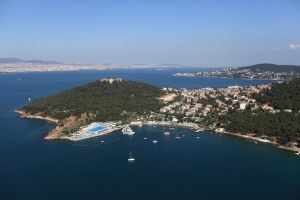 As the visitor approaches the island by ferry he can observe the Greek Orthodox seminary dominating its hill, the Halki Palas Hotel, the former Greek Commercial School (now part of the Naval High School), and the old windmill topping Değirmen Tepesi, above the Water Sports Club.
As the visitor approaches the island by ferry he can observe the Greek Orthodox seminary dominating its hill, the Halki Palas Hotel, the former Greek Commercial School (now part of the Naval High School), and the old windmill topping Değirmen Tepesi, above the Water Sports Club.
The focal point of the village is the ferry landing on the east coast, with the iskele for the sea bus a short distance to its north. The shore road betwen the two iskeles is lined with cafes and restaurants. The principal market street runs parallel to the shore road one short block in from the sea. On the southeastern promontory of the island, next to the ferry landing, is the Deniz Lisesi or Naval High School, with its twin-towered main building and miniature port, and just north of the iskeles is a little fishing port, in which fishing boats and pleasure craft are anchored.
The Greek Orthodox Church of St. Nicholas
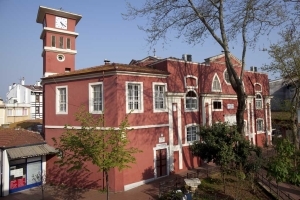 The Greek Orthodox church of St. Nicholas (Hagios Nikolaos) dominates the main square of the village, two short blocks in from the sea bus iskele. It was erected in 1857 on the ruins of a Byzantine church dedicated to St. Nicholas, the patron saint of mariners, appropriate for an island where virtually all of the men were seafarers and fishermen. The architect was Hacı Stefani Gaytanki Kalfa. The church was damaged in the 1894 earthquake, but it was soon afterwards repaired. It is cruciform in plan, with a dome on a high drum covering the central area, supported by four piers, and with barrel vaults over the four arms, a lofty clock-tower campanile rising separately from the main structure. Behind the altar is the tomb of Patriarch Samuel I, who died in 1775. A separate building in front of the narthex houses the hagiasma, or sacred spring, of St. Paraskevi (Hagia Paraskevi).
The Greek Orthodox church of St. Nicholas (Hagios Nikolaos) dominates the main square of the village, two short blocks in from the sea bus iskele. It was erected in 1857 on the ruins of a Byzantine church dedicated to St. Nicholas, the patron saint of mariners, appropriate for an island where virtually all of the men were seafarers and fishermen. The architect was Hacı Stefani Gaytanki Kalfa. The church was damaged in the 1894 earthquake, but it was soon afterwards repaired. It is cruciform in plan, with a dome on a high drum covering the central area, supported by four piers, and with barrel vaults over the four arms, a lofty clock-tower campanile rising separately from the main structure. Behind the altar is the tomb of Patriarch Samuel I, who died in 1775. A separate building in front of the narthex houses the hagiasma, or sacred spring, of St. Paraskevi (Hagia Paraskevi).
Heybeliada - Tour Trough the Woods, Monasteries and Çam Limanı
- Details
- Created on 11 April 2013
- Last Updated on 11 April 2013
Monastery of Hagia Triada
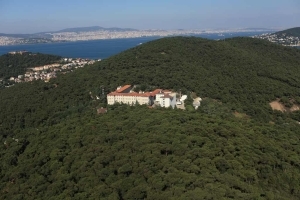 In Byzantine times, there were at least three monasteries on Heybeliada, then known as Halki. The most renowned of these was Hagia Triada, the Holy Trinity, whose site on Ümit Tepesi is occupied by the Greek Orthodox theological school of the same name, a direct descendant of the original Byzantine monastery. The present monastery is the most prominent monument on Heybeliada, dominating the view from an approaching ferry and from within the village itself.
In Byzantine times, there were at least three monasteries on Heybeliada, then known as Halki. The most renowned of these was Hagia Triada, the Holy Trinity, whose site on Ümit Tepesi is occupied by the Greek Orthodox theological school of the same name, a direct descendant of the original Byzantine monastery. The present monastery is the most prominent monument on Heybeliada, dominating the view from an approaching ferry and from within the village itself.
The earliest reference to a monastery on Halki is in the writings of St. Theodore of Studius early in the ninth century. Theodore, abbot of Constantinople’s famous monastery of St. John of Studius, was exiled to a monastery on Halki by Leo V (r. 813-20) because of his criticism of the emperor’s iconoclastic policy. While on Halki, Theodore wrote a number of letters, theological treatises, and poems, one of which was addressed fondly to the monastic cell in which he was confined.
The monastery of the Holy Trinity was restored by the patriarch Photius I (r. 858-67, 877-86), who was twice exiled there, first between his two terms as patriarch and then in the years 887-90. Photius died in the monastery in 890 and was buried there; he was subsequently canonized and is today revered as the patron saint of the Theological School of the Holy Trinity.
The monastery was apparently destroyed at the time of the Turkish Conquest in 1453, moving one anonymous chronicler to lament the loss of what "had earlier been a place where wisdom and knowledge were studied, not only by monks but also by kings and noblemen." In 1550 the monastery was rebuilt or at least partially restored by the future patriarch Metrophanes III (r. 1565-72, 1579-80). Metrophanes also gave to the monastery some three hundred manuscripts, a priceless gift that formed the nucleus of what was to become one of the most renowned libraries in the Orthodox world after that of the Patriarchate in Istanbul.
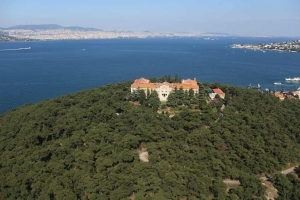 Hagia Triada went through difficult times in the seventeenth and eighteenth centuries, but its finances, at least, improved after Peter the Great, Tsar of Russia (r. 1682-1725), issued a chrysobull giving the monastery a long-term endowment. The monastery was rebuilt and refurbished in 1773 through the efforts of its energetic abbot, Samuel the Deaf. The monastery was badly damaged in 1821, at the beginning of the Greek War of Independence, when it was attacked by a mob and set on fire. The monastery was rebuilt in 1844 by Patriarch Germanos IV, who decreed in a synod that "a theological school should be built for a purpose pleasing to God and dwelt in by theology teachers, priests who wish to learn, and future priests." Wooden buildings were erected to house the classrooms, study hall, teachers’ quarters, student dormitories, refectory, infirmary, and patriarchal apartments, while a two-storey stone structure was built for the library. Then in 1891 a three-storey wing was added to house the administrative offices and new dormitories. All of these structures were seriously damaged in the great earthquake of 1894. Thus a completely new building had to be erected for the monastery, all of the funds for which were provided by the philanthropist Pavlos Skylitsis Stephanovik. The new monastery was designed by the architect Pericles Photiades, and the building was officially dedicated on 6 October 1896, the archimandrite Germanos Gregoras presiding as Rector of the Theological School.
Hagia Triada went through difficult times in the seventeenth and eighteenth centuries, but its finances, at least, improved after Peter the Great, Tsar of Russia (r. 1682-1725), issued a chrysobull giving the monastery a long-term endowment. The monastery was rebuilt and refurbished in 1773 through the efforts of its energetic abbot, Samuel the Deaf. The monastery was badly damaged in 1821, at the beginning of the Greek War of Independence, when it was attacked by a mob and set on fire. The monastery was rebuilt in 1844 by Patriarch Germanos IV, who decreed in a synod that "a theological school should be built for a purpose pleasing to God and dwelt in by theology teachers, priests who wish to learn, and future priests." Wooden buildings were erected to house the classrooms, study hall, teachers’ quarters, student dormitories, refectory, infirmary, and patriarchal apartments, while a two-storey stone structure was built for the library. Then in 1891 a three-storey wing was added to house the administrative offices and new dormitories. All of these structures were seriously damaged in the great earthquake of 1894. Thus a completely new building had to be erected for the monastery, all of the funds for which were provided by the philanthropist Pavlos Skylitsis Stephanovik. The new monastery was designed by the architect Pericles Photiades, and the building was officially dedicated on 6 October 1896, the archimandrite Germanos Gregoras presiding as Rector of the Theological School.
Read more: Heybeliada - Tour Trough the Woods, Monasteries and Çam Limanı
Burgazada - Center
- Details
- Created on 18 February 2013
- Last Updated on 11 April 2013
The İskele
 The iskele for the sea bus is a short distance to the north of the regular ferry landing on the northeast coast of the island. There are several cafes and restaurants on the seafront around the ferry landings. Faytons wait for hire beside the park between the two piers.
The iskele for the sea bus is a short distance to the north of the regular ferry landing on the northeast coast of the island. There are several cafes and restaurants on the seafront around the ferry landings. Faytons wait for hire beside the park between the two piers.
Beaches
Motorboats can be hired near the iskeles to take the visitor to pebble beaches on the south and west shores of the island. The Adalar Su Sporları (water sports) club, with an Olympic-size swimming pool, is on Molozburnu, the promontory just to the south of the ferry landing.
The Greek Orthodox Church of Hagios Ioannis Prodromos
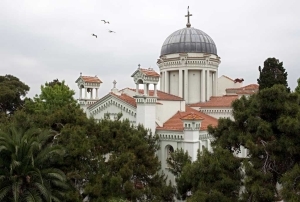 The Greek Orthodox church of Hagios Ioannis Prodromos, St. John the Baptist, is the most prominent monument in the village, its dome, raised on a high drum, dominating the view as seen from the ferry as one approaches the iskele. The church is a short way from the seafront on the first street to the south of the ferry landing.
The Greek Orthodox church of Hagios Ioannis Prodromos, St. John the Baptist, is the most prominent monument in the village, its dome, raised on a high drum, dominating the view as seen from the ferry as one approaches the iskele. The church is a short way from the seafront on the first street to the south of the ferry landing.
The present church, built in 1899, is believed to stand on the site of the katholikon of the Byzantine monastery of St. John. The original katholikon was probably built in the eleventh century, and parts of its structure are thought to be incorporated in the present church, which seems to retain the plan of the earlier structure. The evidence for this conclusion is presented by George Mastoropoulos in his Patriarchal Monasteries of the Princes’ Islands.
On the left side of the narthex, or vestibule, a stairway leads down to a small subterranean crypt with a vaulted ceiling. The crypt is dedicated to St. Methodios, for this is believed to be the dungeon in which he was imprisoned by Michael II, and where he remained for seven years before being released by the emperor Theophilos. Grosvenor describes the ordeal that Methodius endured before going to his final rest:
At Antigone, Theodora erected the Church of St. John the Baptist over the cave where the Confessor had been so long confined. In the renovated modern wooden [actually stone and brick] church, still the chief sanctuary of the islanders, little remains of the early edifice. Nevertheless the apse, or eastern portion, is part of the original structure.
Burgazada - Beyond the Center
- Details
- Created on 11 April 2013
- Last Updated on 11 April 2013
The Monastery of Hagios Georgios
 The Greek Orthodox monastery of Hagios Georgios (St. George) Karyptis is on the northern shore of the island, approached from Gönüllü Caddesi. The gateway leads to the grounds of the katholikon, from which a flight of steps leads down to the dormitory of the monastery, a two-storey stone building.
The Greek Orthodox monastery of Hagios Georgios (St. George) Karyptis is on the northern shore of the island, approached from Gönüllü Caddesi. The gateway leads to the grounds of the katholikon, from which a flight of steps leads down to the dormitory of the monastery, a two-storey stone building.
Although the monastery is believed to have been founded in the Byzantine era, the earliest reference to it is in the second half of the seventeenth century. This is when the Greek innkeepers of Istanbul decided to restore and maintain the monastery, which apparently had fallen into ruins.
The present church was built in 1897 on an endowment provided by Simeon Sinyosoğlu. It is built on the Greek-cross plan of medieval Byzantine architecture, probably repeating the design of the original katholikon. The church has a particularly fine iconostasis, carved out of wood and embossed with gold, and also an episcopal throne of finely-carved wood. On the reverse side of the icons are inscribed the words: "By thy servant Joachim, Monk from Crete, in the year of our Blessed Lord 1818." The iconostasis dates from the eighteenth century and is undoubtedly from the katholikon of the earlier monastery.
Hristos (Christ) Tepesi and the Byzantine Monastery of the Theokoryphotos
 The site of the Byzantine monastery of the Theokoryphotos, the Transfiguration of Christ, is on the summit of Hristos (Christ) Tepesi, as suggested by the name of the hill. Greek tradition, unverified by the Byzantine sources, has it that the monastery was founded by the emperor Basil I the Macedonian (r. 867-86) on the ruins of an ancient Greek temple. There is evidence of a chrysobull of the emperor Manuel I Comnenos granting the Theokoryphotos its rights as a monastery in 1158. The earliest reference to the monastery after the conquest is c. 1547 by the French scholar Petrus Gyllius, who reported that it was virtually intact.
The site of the Byzantine monastery of the Theokoryphotos, the Transfiguration of Christ, is on the summit of Hristos (Christ) Tepesi, as suggested by the name of the hill. Greek tradition, unverified by the Byzantine sources, has it that the monastery was founded by the emperor Basil I the Macedonian (r. 867-86) on the ruins of an ancient Greek temple. There is evidence of a chrysobull of the emperor Manuel I Comnenos granting the Theokoryphotos its rights as a monastery in 1158. The earliest reference to the monastery after the conquest is c. 1547 by the French scholar Petrus Gyllius, who reported that it was virtually intact.
But by the end of the eighteenth century the monastery was an abandoned ruin.
All that remains is a nineteenth-century church and a two-storey building erected in the eighteenth century, along with the ruins and architectural fragments of earlier structures scattered about the former enclosure of the monastery. Inside the entrance to the enclosure there are a number of ancient architectural fragments that include four beautifully carved Byzantine capitals.
Within the monastery precinct are four large vaulted underground cisterns which still collect rainwater even today
The view from the hilltop is superb, with all of the other islands of the archipelago in view as well as the Asian shore of the mainland opposite. Greeks and others still come to the church to mark the panigiri of the Transfiguration on August 6, which in times past would have been celebrated with music and dancing on the hilltop.
The Greek cemetery is just above the site of the monastery. The little church in the cemetery is dedicated to Hagios Profitis Ilias, the Prophet Elijah, whose chapels are always on hilltops.
Kınalıada
- Details
- Created on 18 February 2013
- Last Updated on 11 April 2013
Village Center
 The focal point of the village, here as in the other three major isles, is the vapur iskelesi, or ferry landing, on the northeast shore. The new iskele for the sea bus is just beside the pier for the regular ferry on its south side.
The focal point of the village, here as in the other three major isles, is the vapur iskelesi, or ferry landing, on the northeast shore. The new iskele for the sea bus is just beside the pier for the regular ferry on its south side.
Kınalıada is the only one of the four larger isles that does not have faytons (horse carriages), and so those who want to explore the uninhabited western side of the island must do so on foot or by bicycle. Local residents claim to prefer the absence of horses which renders the island more sweet-smelling than its sisters. In any case, the island is so small that any destination can be reached within a few minutes’ walk.
The Greek Orthodox Church
The Greek Orthodox church is on Çınarlı Köşk Sokağı, a short way in from the shore road. The church is dedicated to the Genissa Panagia Theotokou, the Birth of the All Holy Mother of God, and was founded in 1886. The church is in the form of a three-aisled basilica with a narthex, entered from a courtyard-garden to its south. In the narthex there is a silver-clad icon depicting the Birth of the Virgin. There are other silver-clad icons on the iconostasis, or icon screen, which separates the nave from the sanctuary. The church celebrates the panigiri, or feast-day, of the Virgin’s birth on 7-8 October.
Surp Krikor Lusavoriç, Armenian Gregorian Church
 The Armenian Gregorian church is on Narçiçeğı Sokağı, on the third block in from the shore road. This was the first and only Armenian Gregorian church built on the islands. The church was founded in 1857 and is dedicated to Surp Krikor Lusavoriç, St. Gregory the Illuminator. The present church is the result of a complete reconstruction in 1988.
The Armenian Gregorian church is on Narçiçeğı Sokağı, on the third block in from the shore road. This was the first and only Armenian Gregorian church built on the islands. The church was founded in 1857 and is dedicated to Surp Krikor Lusavoriç, St. Gregory the Illuminator. The present church is the result of a complete reconstruction in 1988.
The altar curtain was taken from the Armenian church of St. Auxent in Trabzon. Behind the altar there is a painting of the Virgin and Christ Child. The altar is flanked by two paintings, the one on the left depicting St. Gregory the Illuminator, founder of the Armenian Gregorian Church, while the one on the right shows St. Nerses, patriarch of the Gregorian Armenian Church in the mid-fourth century. The side altar on the right is dedicated to St. Gregory, who is shown holding a model of the cathedral that he built at Etchmiadzin in Armenia. On the side walls of the nave there are panels containing attractive stone carvings in the medieval Armenian style. One of the panels commemorates the great Armenian composer Gomidas, who had a summer home on Kınalı during the years 1909-13.
Kınalıada Mosque
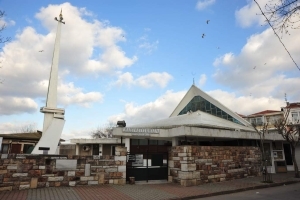 The Muslim community worships in Kınalıada Camii, which stands on the shore south of the iskele. The mosque was built in 1956 by the architect Başar Acarlı in a modern abstract style.
The Muslim community worships in Kınalıada Camii, which stands on the shore south of the iskele. The mosque was built in 1956 by the architect Başar Acarlı in a modern abstract style.
Monastery of the Transfiguration
 The present monastery of the Transfiguration is near the peak of Manastir Tepesi. This was built on the site of the Byzantine monastery of the same name, of which a number of architectural fragments have been built into the katholikon, or monastic church, while others lie scattered around the grounds. After the Turkish Conquest the monastery began to fall into ruins, but in 1722 a group of wealthy Greek merchants from Chios, who were doing business in Istanbul, financed a major restoration, building a new church on the site of the Byzantine katholikon and adding a side chapel dedicated to St. Paraskevi. The iconostasis and episcopal throne are in finely carved wood. The Byzantine icons from the original katholikon are preserved in the Greek Orthodox Patriarchate in Istanbul. The icons on the iconostasis of the present church are Russian works sent in 1723 to the patriarch Jeremias III from Tsar Peter the Great.
The present monastery of the Transfiguration is near the peak of Manastir Tepesi. This was built on the site of the Byzantine monastery of the same name, of which a number of architectural fragments have been built into the katholikon, or monastic church, while others lie scattered around the grounds. After the Turkish Conquest the monastery began to fall into ruins, but in 1722 a group of wealthy Greek merchants from Chios, who were doing business in Istanbul, financed a major restoration, building a new church on the site of the Byzantine katholikon and adding a side chapel dedicated to St. Paraskevi. The iconostasis and episcopal throne are in finely carved wood. The Byzantine icons from the original katholikon are preserved in the Greek Orthodox Patriarchate in Istanbul. The icons on the iconostasis of the present church are Russian works sent in 1723 to the patriarch Jeremias III from Tsar Peter the Great.
Sedefadası - Antirovithos
- Details
- Created on 18 February 2013
- Last Updated on 13 May 2013
Monastery
St. Ignatius founded a monastery for men on Antirovithos, in the mid-ninth century, one of three monatic esablishments he built on the Princes' Isles, all of which are mentioned in the list made by Manuel I Comnenus in 1158. The monastery on Antirovithos was rrestored in 1180 by the patriarch theodosius Boradiotis. All that remains of the monastery today is a fragmentary ruin on the northwestern promontory of the island.
Museums, Cultural Centers
- Details
- Created on 15 July 2014
- Last Updated on 01 August 2014
Museums
Büyükada
Museum of the Princes' Islands
Aya Nikola Mevkii, Maden, Büyükada
Tel: 0216 382 6430
St. Nicholas Hangar Museum Site is closed on Mondays.
Admission Fees: Fee 5.-TL, Discount 3.-TL, Free of charge on Wednesday.
www.adalarmuzesi.org/cms/english
Adalar Müzesi Açık Sergi Alanı
Çelik Gülersoy Kültür ve Sanat Merkezi, Çınar Cd Büyükada
Hergün 09.00 - 19.00 saatleri arası açık
Tel: 0216 382 5280
Admission Fees: Free
www.adalarmuzesi.org/cms/english
Heybeliada
İnönü Evi Müzesi
Refah Şehitleri Cd, Heybeliada
Tel: 0216 351 8449
Pazartesi hariç, hergün 10:00 - 18:00 saatleri arası açık
Giriş: Ücretsiz
Web Sayfası
Hüseyin Rahmi Gürpınar Müzesi
Demirtaş Sk. Heybeliada
Tel: 0530 227 0567
Giriş: Ücretsiz
(Ev restorasyon nedeniyle özel izinle ziyaret edilebilmektedir.)
Burgazada
Sait Faik Müzesi
Çayır Sokak, No:15 Burgazada, İstanbul
Tel. 0216 381 2060
Pazartesi - Salı hariç, hergün 10.00 - 18.30 saatleri arasında açık
Giriş: Ücretsiz
www.saitfaikmuzesi.org
Cultural Centers
Büyükada
Adaevi
Çelik Gülersoy Kültür ve Sanat Merkezi, Çınar cd. Büyükada
Tel: 0216 382 5280
Hergün 09.00 - 19.00 saatleri arası açık
http://www.adalarmuzesi.org/cms/english
Adalar Kültür Derneği
Çınar Meydanı No. 14 Büyükada
Tel: 0216 382 7378
This email address is being protected from spambots. You need JavaScript enabled to view it." target="_blank">This email address is being protected from spambots. You need JavaScript enabled to view it.
Boat Tours
- Details
- Created on 10 March 2013
- Last Updated on 01 August 2014
Büyükada- Heybeliada Tour by Boat
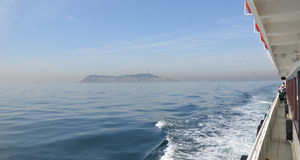 Discover the Princes' Islands from the sea. Visit the natural splendor of the Islands' shores, bays, Byzantine monastaries, famous houses and mansions as well as the Museum.
Discover the Princes' Islands from the sea. Visit the natural splendor of the Islands' shores, bays, Byzantine monastaries, famous houses and mansions as well as the Museum.
Heybeliada and Büyükada are two of the most important islands of the Princes' Islands. Travelling around both these islands is as informative about the colorful lifestyles of those who lived there as it is exhilerating.Monasteries, churches, mosques side by side. The houses and mansions of celebrities who live and have lived on the islands. All the variations of the color green, the unique flora, beautiful bays and harbours. The Museum of the Princes' Islands visit on the St. Nicholas Bay.
Attention: Halki Seminary may be added to tours upon request.
Museum of the Princes' Islands
Museum of the Princes’ Islands is the first contemporary city museum of Istanbul.
It tells the story of the Islands from the geological formation of the Islands to the present day, displaying hundreds of objects and utilising twenty thousand Ottoman archival documents, six thousand digital photographs, hundreds of documentary films, documentation and filming of today’s Islands, archival records of public institutions of the Islands, temporary and permanent donations of the Islanders.
Other Tours:
Büyükada Historical Gardens and Island Garden Culture Tour
Büyükada and Heybeliada Bike Tours
INFORMATION and CONTACT for TOURS
Upon request, hiking, biking and boat tours are being organized with contracted trip agencies and licensed tourist guides. Upon request, boat tours are being organized with contracted trip agencies and licensed tourist guides.
After organizing your group, you can ask for quotation from tel 0 216 382 6430 or e-mail address This email address is being protected from spambots. You need JavaScript enabled to view it..
Excursions and Tours
- Details
- Created on 04 March 2013
- Last Updated on 01 August 2014
Büyükada Walking Tour
 Discover the architecture, history and nature of Büyükada with a professional tour guide.
Discover the architecture, history and nature of Büyükada with a professional tour guide.
Tour Route:
April-May: Splendid Hotel, Anatolian Club, Famous Mansions(Fabiato, Hacopulo, Mizzi, Arap İzzet Paşa, Con Paşa mansions, Trotsky House) the Greek Orphanage(the tour is seperated in two after this)
A route: Christos Monastary, San Pasifiko catholic Church, Hamidiye Mosque, The Museum of the Princes' Islands Çınar Exhibition area, Saint Dimitri Orthodox Church
B route: Lunapark Square, Saint Nicholas Monastary, the Museum of the Princes' Islands, the House of Reşat Nuri Güntekin
June-September: Splendid hotel, Anatolian Club, Famous Mansions(Fabiato, Hacopulo, Mizzi, Arap İzzet Paşa, Con Paşa mansions, Trotsky House), the Greek orphanage, Lunapark Square, St. Nicholas Monastary, the Museum of the Princes' Islands. Transfer to the center of the Island by boat. St. Dimitri Orthodox church, Hamidiye mosque, The Museum of the Princes' Islands Çınar exhibition area.
Heybeliada Walking Tour
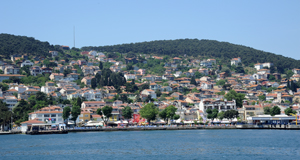 Discover the architecture, history and nature of Heybeliada with a professional tour guide.
Discover the architecture, history and nature of Heybeliada with a professional tour guide.
Tour Route:
Sr. Nicholas Orthodox Church, Halki Seminary and the St. Trinity Church, famous mansions(İliasko twin mansions, Khedive of Egypt Abbas Hilmi Paşa, Selanik governor Hulusi Bey)
Büyükada- Heybeliada Tour by Boat
 Discover the Princes' Islands from the sea. Visit the natural splendor of the Islands' shores, bays, Byzantine monastaries, famous houses and mansions as well as the Museum.
Discover the Princes' Islands from the sea. Visit the natural splendor of the Islands' shores, bays, Byzantine monastaries, famous houses and mansions as well as the Museum.
Heybeliada and Büyükada are two of the most important islands of the Princes' Islands. Travelling around both these islands is as informative about the colorful lifestyles of those who lived there as it is exhilerating.Monasteries, churches, mosques side by side. The houses and mansions of celebrities who live and have lived on the islands. All the variations of the color green, the unique flora, beautiful bays and harbours. The Museum of the Princes' Islands visit on the St. Nicholas Bay.
Nightlife
- Details
- Created on 06 March 2013
- Last Updated on 01 April 2013
Island nights start to liven up after sunset. During summer you can choose one of the many bars, cafes, restaurants and taverns concentrated around the piers on all of the four islands. The rest of the year you will definitely hear some music on Büyükada, Heybeli and Burgaz during Friday and Saturday nights.
Büyükada
Büyükada, Taverna, Bar, Pub, Gülistan Caddesi,
Prinkipo Restaurant, Taverna, Bar, Gülistan Caddesi
İpek’s Cafe, Restaurant, Bar, İskele, 23 Nisan Caddesi, Rezervasyon 0216 382 79 00
Heybeliada
Perili Köşk Jazz Bar, Ay yıldız Cad. No:103 - Telefon: 351 87 10
Lady Café, Ay yıldız Cad. No:16 - Telefon: 351 90 17
Beaches
- Details
- Created on 11 June 2013
- Last Updated on 30 July 2014
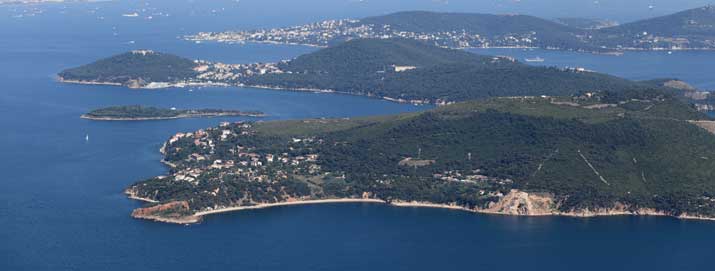
Sea around Islands are the cleanest around İstanbul. Pollution is regularly under control. (You can see measurements from the map at the end of this page.)
Sea Temperature is over 20 degrees since beginning of June. It is very convenient for swimming from June to November. (You can see measurements from the table at the end of this page)
There are nice beaches on the Islands. You can find them on 5 Islands (Büyükada, Heybeliada, Burgazada and Sedef Island). There are free shuttle boats to beaches at every pier on the Islands, please ask at Piers.
Entrances to beaches are charged, please ask the charge before boarding to boats. There are changing rooms and chaise lounges on the beaches.
There are free places for swimming on the coast of the Islands. There may be chaise lounges for rent but you don’t have to rent them for swimming.
Bathing Water Analysis
- Details
- Created on 18 July 2014
- Last Updated on 20 July 2014
Sea water analysis are carried out by the Istanbul Provincial Directorate of Health. After the year 2011 the measurement data is published in the Internet. Basically, the water quality is measured using the items and categorised after them.
Coliform bacteria are a commonly used bacterial indicator of sanitary quality of foods and water. They are defined as rod-shaped Gram-negative non-spore forming bacteria which can ferment lactose with the production of acid and gas when incubated at 35–37°C. Coliforms can be found in the aquatic environment, in soil and on vegetation; they are universally present in large numbers in the feces of warm-blooded animals. While coliforms themselves are not normally causes of serious illness, they are easy to culture and their presence is used to indicate that other pathogenic organisms of fecal origin may be present. Such pathogens include bacteria, viruses, or protozoa and many multicellular parasites. Coliform procedures are performed in aerobic or reduced oxygen conditions.
So, fecal coliforms are emerging as a result of evacuation.
BÜYÜKADA - IN FRONT OF YÖRÜKALİ BEACH
- Details
- Created on 18 July 2014
- Last Updated on 02 August 2015

BÜYÜKADA - IN FRONT OF SEFEROĞLU FACILITIES
- Details
- Created on 18 July 2014
- Last Updated on 02 August 2015
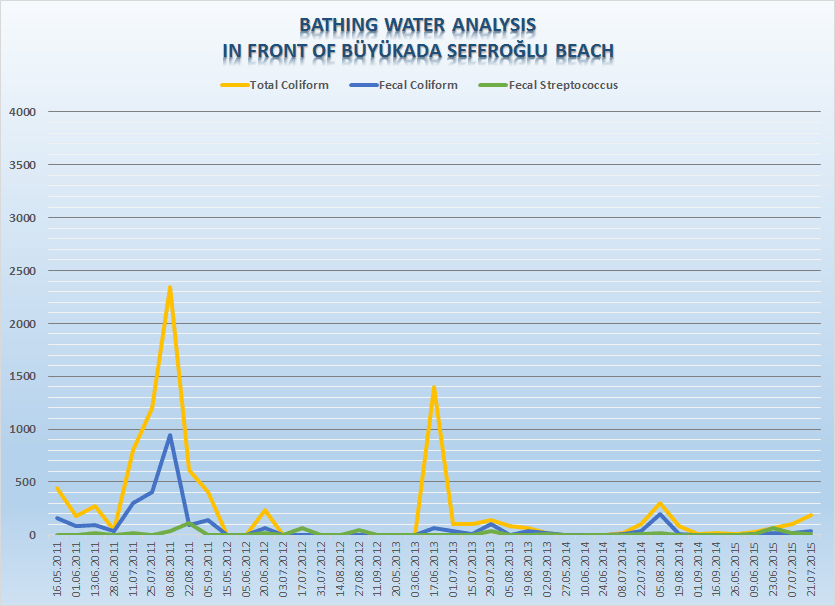
BÜYÜKADA - IN FRONT OF WATER SPORTS CLUB
- Details
- Created on 18 July 2014
- Last Updated on 02 August 2015

HEYBELİADA - IN FRONT OF SADIKBEY BEACH
- Details
- Created on 18 July 2014
- Last Updated on 02 August 2015

HEYBELİADA - IN FRONT OF WATER SPORTS CLUB
- Details
- Created on 18 July 2014
- Last Updated on 02 August 2015

BURGAZADA - IN FRONT OF WATER SPORTS CLUB
- Details
- Created on 18 July 2014
- Last Updated on 02 August 2015
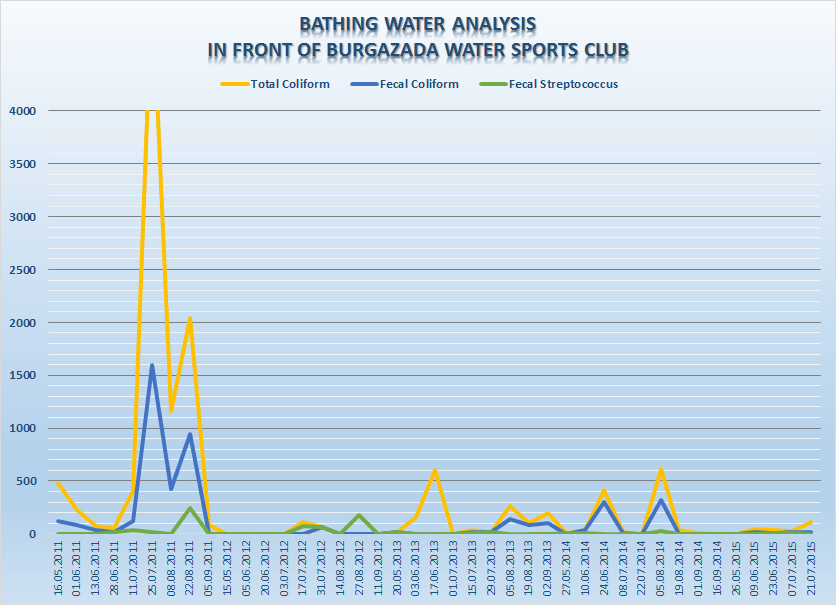
KINALIADA - IN FRONT OF WATER SPORTS CLUB
- Details
- Created on 18 July 2014
- Last Updated on 02 August 2015
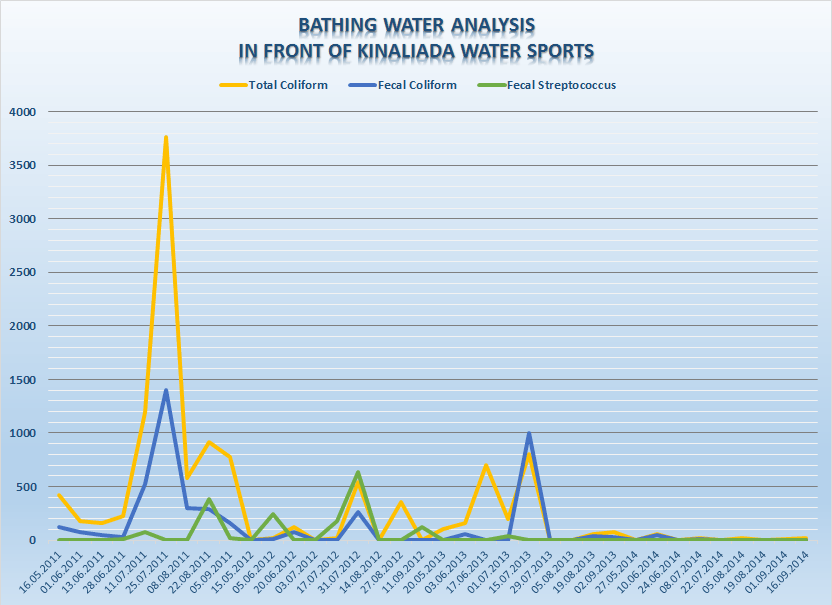
KINALIADA - IN FRONT OF ÜLKER RESTAURANT
- Details
- Created on 18 July 2014
- Last Updated on 02 August 2015
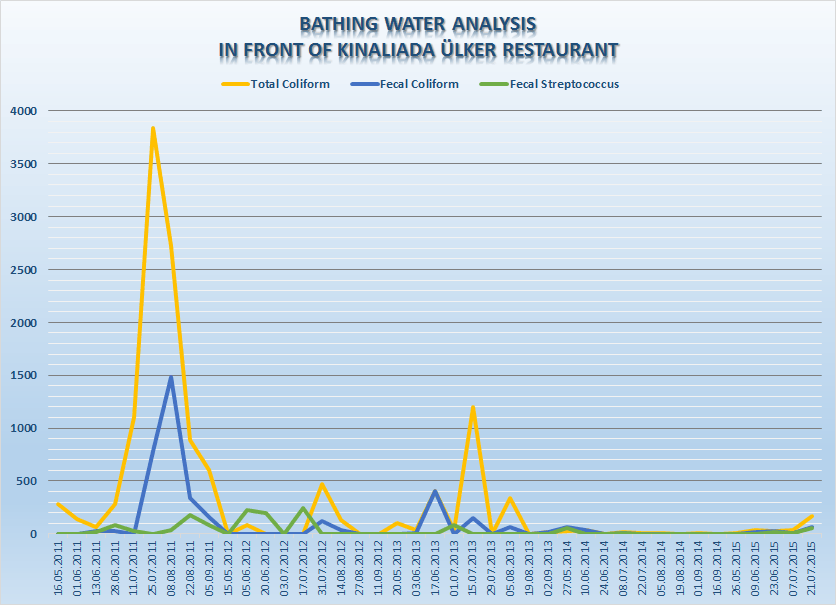
İstanbul Long Term Average Temperatures
- Details
- Created on 21 July 2014
- Last Updated on 21 July 2014
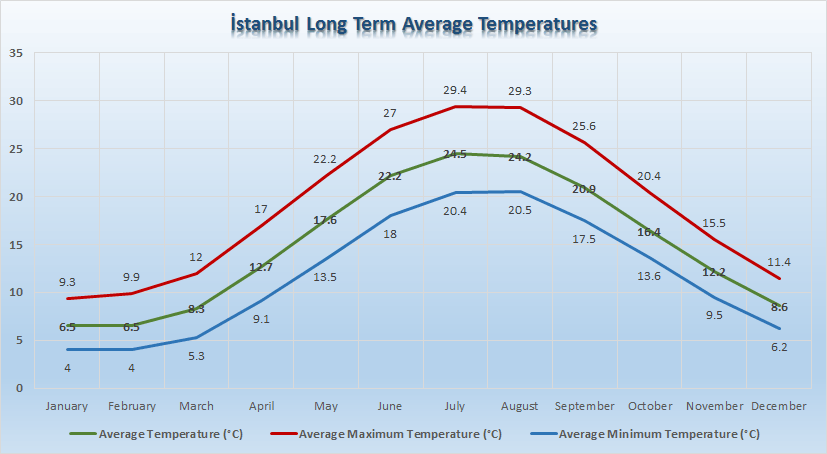
İstanbul Long Term Average Sunshine Durations
- Details
- Created on 21 July 2014
- Last Updated on 21 July 2014

İstanbul Long Term Average Precipitation
- Details
- Created on 21 July 2014
- Last Updated on 21 July 2014
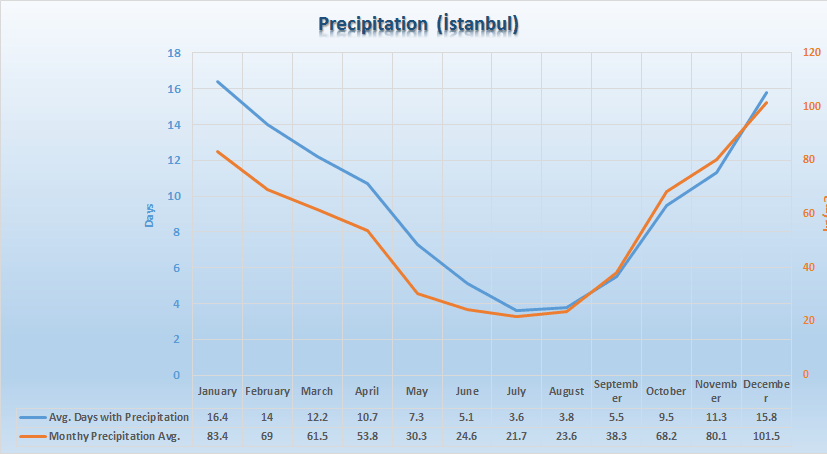
Distibution of the Population among the Islands
- Details
- Created on 23 July 2014
- Last Updated on 23 July 2014
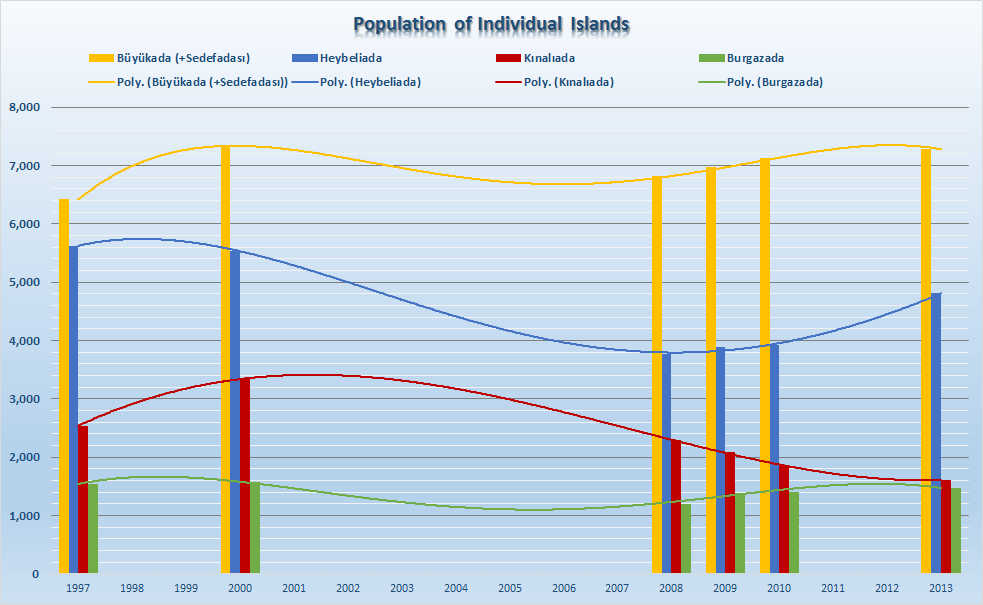
Subcategories
- Home
- Princes’ Islands
- History
- Practical İnformation
- Where To Stay
- Restaurants
- What To See
- What To Do
- F.A.Q
- Academic
-
Statistics
In this section you can find statistics collected from several offical resources.
Bathing water analysis / quality, sea temperatures, weather statistics, population and demographic statistics of the Pricess' Islands can be found here.
-
Bathing Water Analysis
This section is composed of bathing water snalysis results from measurements around the islands. These measurements are carried out around the four islands, in front of the 11 beaches during the summer season.
- Sea Temperatures
- Weather Reports
- Population and Demographics
-
Bathing Water Analysis





